SR-SIM deployment
This chapter describes the SR-SIM deployment options.
Making the SR-SIM image available to the container management system
To use the SR-SIM container image in a containerized environment, an operator must import the downloaded image into a local container registry.
A container registry is a storage area made available to the container management system (such as Docker) to place copies of container images that are used to deploy and start containers.
- local/internal - stored on a customer authorized site and available to container management systems specifically authorized to obtain container images from the registry
- public - anyone on the internet may obtain a container image from the registry, with or without authorization
Example: Importing the SR-SIM image into a local Docker container registry
The following is an example of the process to place the downloaded SR-SIM
container image srsim.tar.xz (example filename) into a local container
registry provided in the Docker container management system.
bash# docker load -i srsim.tar.xz
Loaded image: localhost/nokia/srsim:25.10.R1
bash# docker image ls
docker image ls localhost/nokia/srsim:25.10.R1
REPOSITORY TAG IMAGE ID CREATED SIZE
localhost/nokia/srsim 25.10.R1 7deaabababc0 10 days ago 2.1GB
bash# docker image ls
docker tag localhost/nokia/srsim:25.10.R1 srsim:25.10.R1The image is now available for use, named
srsim:25.10.R1.
Example: Importing the SR-SIM image into a local Kubernetes container registry
srsim.tar.xz (example filename) into a local container
registry available on localhost:32000 that has been deployed into a
Kubernetes environment. bash# docker load -i srsim.tar.xz
Loaded image: localhost/nokia/srsim:25.10.R1
bash# docker image ls
docker image ls localhost/nokia/srsim:25.10.R1
REPOSITORY TAG IMAGE ID CREATED SIZE
localhost/nokia/srsim 25.10.R1 7deaabababc0 10 days ago 2.1GB
bash# docker tag localhost/nokia/srsim:25.10.R1 localhost:32000/nokia/srsim:25.10.R1
bash# docker image ls
docker image ls localhost:32000/nokia/srsim:25.10.R1
REPOSITORY TAG IMAGE ID CREATED SIZE
localhost/nokia/srsim 25.10.R1 7deaabababc0 10 days ago 2.1GB
bash# docker push localhost:32000/nokia/srsim: 25.10.R1
The push refers to repository [localhost:32000/nokia/srsim]
01a1febdbeca: Mounted from srsim
25.10.R1: digest: sha256:7deaabababc08555ccea1ff26a7b5776ee8445e63c0e51bddbcc826544b966a6 size: 52The image is now available for use, named
localhost:32000/nokia/srsim:25.10.R1.
Deploying the SR-SIM
This section describes how to deploy and configure the SR-SIM for use in some common container management systems.
An example is provided for each container management solution for an integrated model SR-SIM and a distributed model SR-SIM.
- the container image has been imported into a local registry and has been tagged appropriately
- the license subscription file provided by Nokia is stored on the local filesystem in
/tmp/license.txt
Docker
Docker is one of the most common container management systems.
To correctly forward packets to interfaces facing the SR-SIM, disable the IP generic checksums on the bridge interfaces used. This bridge interface should also support an MTU of 9000.
You can use the default docker bridge interface or create SR-SIM bridges specifically for the management network.
Use the following UNIX command to disable TX generic IP checksums for the
interface <interface>.
sudo ethtool -K <interface> tx-checksum-ip-generic offBy default, unless the environment variables provided override it, the first network attached to a container is treated as the management interface, and the second, as the fabric interface (where required).
Using Docker to deploy the SR-SIM
This section describes how to deploy the SR-SIM in integrated and distributed modes, using Docker.
In the deployment examples that follow, a management network is
created as a Docker bridge network with the appropriate MTU and
other required settings. This network is named
srsim_mgmt.
Use the following commands to create and configure the management
network srsim_mgmt in Docker.
docker network create --driver bridge --subnet 10.77.140.0/24 --gateway 10.77.140.1 --opt com.docker.network.driver.mtu=9000 --opt com.docker.network.bridge.name=srsim_mgmt srsim_mgmtIn the preceding case, the srsim_mgmt network is
configured to automatically allocate a management IPv4 address to each SR-SIM
container as it is started from the range 10.77.140.0/24.
Use the following command to disable TX generic IP checksums for the
srsim_mgmt interface.
sudo ethtool -K srsim_mgmt tx-checksum-ip-generic offUse the following command to remove the management network at any time.
docker network rm srsim_mgmtIntegrated
Deploying the SR-SIM
in integrated mode using Docker is straightforward. In the deployment example that
follows, the command is used to create an SR-1 simulator named srsim1
with the SSH protocol bound to port 2222 of the localhost.
This deployment (optionally) connects the current TTY and STDIN to this device, essentially providing console on the SR-SIM.
docker run --privileged --rm --name srsim1 -t -i --network srsim_mgmt -p 2222:22 -v /tmp/license.txt:/nokia/license/license.txt localhost:32000/srsim:latestThe command consists of the following component parts:
--priviledgedruns the container with additional privileged on the host machine. This is required in order to operate as a router with it's own networking stack, rather than running on top of another network stack.--rm(optional) deletes the container from the container management system (Docker) when the container stops. If this is not provided, when the container is stopped it will remain in a stopped state but will not be removed.--name(optional) is the name of the container. A name will be dynamically allocated by the container management system (Docker) if this is not provided.-t(optional) allocates a TTY to the container in order to allow console access to the router.-i(optional) ensures STDIN is redirected to the container in order to allow console access to the router.-p 2222:22redirects TCP port2222on the local system to port22inside the container. Port22is the SSH service on SR OS. This flag can be provided more than once to redirect additional ports following the format-p <source port>:<destination port>for a TCP port and-p <source port>/udp:<destination port>/udpfor a UDP port.-v /tmp/license.txt:/nokia/license/license.txtmounts the local file/tmp/license.txtas the file/nokia/license/license.txtinside the container. This is the license file, however, the same approach may be taken to mount other files and directories inside the SR-SIM container.
To stop the created container, which was named
srsim1, use the following command in
another shell session:
docker container stop srsim1As the --rm flag was used to create the
container, the container is both stopped and removed.
The more common deployment of the SR-SIM is to run it in the background, so that it remains running, and use SSH to connect to the device. This more accurately mimics operational deployments.
To deploy the integrated mode SR-SIM
in this way, remove the -t and -i flags from the
command syntax, and add the -d flag. This detaches the container from
the session, allowing it to run independently.
The deployment command is as follows.
docker run --privileged --rm --name srsim1 -d --network srsim_mgmt -p 2222:22 -v /tmp/license.txt:/nokia/license/license.txt localhost:32000/srsim:latestUse the following command to confirm the container is running.
docker container lsUse the following top style tool to check your
container.
docker statsUse the following command to view the console and look at the boot sequence of the SR-SIM.
docker logs -f srsim1Use the following command to identify the IP address allocated to the SR-SIM.
docker inspect srsim1 | grep "10.77.140" | grep "IPAddress"To connect to the newly created SR-SIM, SSH to the local host machine (by using its IP address or name).
For example ssh -l admin -p 2222 localhost or
ssh -l admin 10.77.140.2 (assuming your SR-SIM
was allocated the 10.77.140.2 address).
Detached containers are stopped in the same way as interactive containers, using this command.
docker container stop srsim1As the --rm flag was used to create the
container, the container is both stopped and removed.
Use the following command to deploy an SR-SIM that is emulating an IXR-e2.
docker run --privileged --rm --name srsim1 -d --network srsim_mgmt -p 2222:22 -v /tmp/license.txt:/nokia/license/license.txt -e NOKIA_SROS_CHASSIS=ixr-e2 srsim:latestThe additional -e flag is used in the preceding
command. This sets an environment variable and it can be provided multiple times. As
described in Environment variables, the SR-SIM
uses environment variables to identify the hardware to emulate and perform some initial
configuration.
The following topology can be deployed with the following Docker commands.
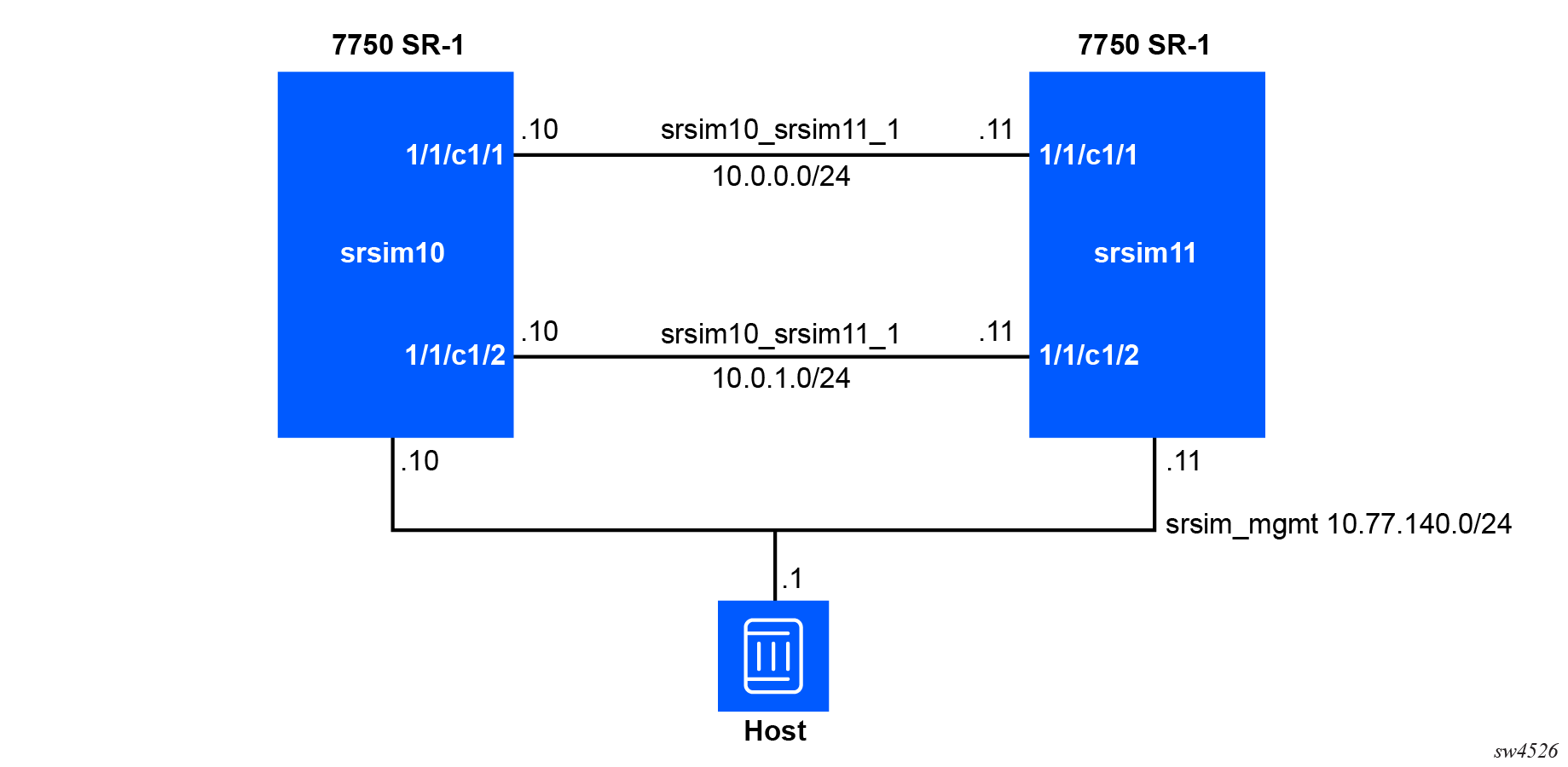
In the preceding example, while the management network
srsim_mgmt is already set up, the user
needs to create datapath networks
srsim10_srsim11_1 and
srsim10_srsim11_2 between the two routers.
Use the following commands to create each datapath network.
docker network create srsim10_srsim11_1
docker network create srsim10_srsim11_2docker run --privileged --rm --name srsim10 -d \
--network srsim_mgmt --ip 10.77.140.10 \
--network=name=srsim10_srsim11_1,driver-opt=com.docker.network.endpoint.ifname=e1-1-c1-1 \
--network=name=srsim10_srsim11_2,driver-opt=com.docker.network.endpoint.ifname=e1-1-c1-2 \
-v /tmp/license.txt:/nokia/license/license.txt \
-v ./srsim10.cfg:/nokia/config/config.cfg \
localhost:32000/srsim:25.10.R1
docker run --privileged --rm --name srsim11 -d \
--network srsim_mgmt --ip 10.77.140.11 \
--network=name=srsim10_srsim11_1,driver-opt=com.docker.network.endpoint.ifname=e1-1-c1-1 \
--network=name=srsim10_srsim11_2,driver-opt=com.docker.network.endpoint.ifname=e1-1-c1-2 \
-v /tmp/license.txt:/nokia/license/license.txt \
-v ./srsim11.cfg:/nokia/config/config.cfg \
localhost:32000/srsim:25.10.R1The following important considerations apply to the preceding commands:
- The order of the
networkstatements is important. The SR-SIM expects the management interface will be attached toeth0inside the container. To ensure this occurs automatically, specify the management network (in this examplesrsim_mgmt) as the first network in this configuration. - The
--ipoption provisions a static IP address to the container. This IP address must be within the range configured on the network. - The statement
--network=name=srsim10_srsim11_1,driver-opt=com.docker.network.endpoint.ifname=e1-1-c1-1attaches a datapath interface to the container. Datapath interfaces in the SR-SIM are automatically bound to the SR OS ports. To achieve this binding, the container interface name must follow the matching convention for the ports. In this example,e1-1-c1-1will be bound to the SR OS port1/1/c1/1. - The statement
-v ./srsim10.cfg:/nokia/config/config.cfgmounts a valid SR OS configuration file into the container, which the SR-SIM uses to boot. If no configuration file is provided, the default configuration is used. If a configuration file is provided, it is used only if valid. The-voption takes the formsource:destination. In this example, thesrsim10.cfgfile from the current directory is mounted inside the container as/nokia/config/config.cfg.
Use the following command to destroy the SR-SIM
instances srsim10 and srsim11.
docker container stop srsim10 srsim11Distributed
Starting the SR-SIM in distributed mode using Docker requires slightly more preparation than the integrated mode, however it remains simple to deploy.
To deploy the SR-SIM in a distributed mode inside Docker requires consideration of the following additional items:
- each slot of the system will be its own container (including
slots
aandb, as well as the numbered slots1onward) - each container requires the license file to be provided
- each container requires a management interface (even if it is not a CPM)
- each container requires access to the fabric bridge
- the fabric bridge should not be shared between SR-SIM devices
The following command creates an SR-7 simulator that comprises of two CPMs and two linecards. The SSH protocol is exposed on the primary and secondary CPMs (on different ports as Docker cannot expose the same local port to multiple containers). This deployment example runs all containers in the background.
In the distributed mode, each linecard of each router requires its own container. The following figure shows the network diagram for the example network that will be created.
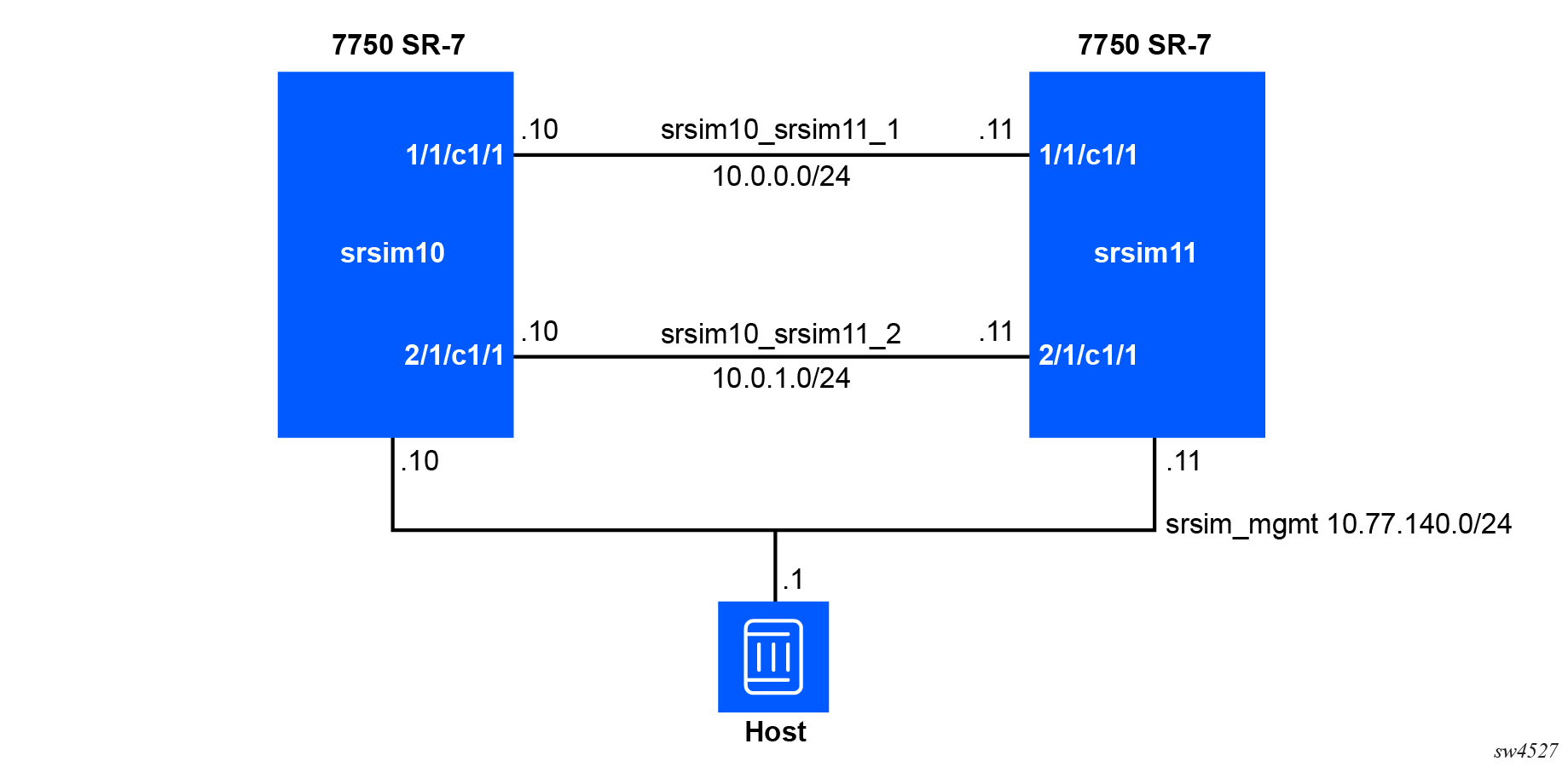
Each router consists of a number of containers. The
srsim10 router container layout is shown
here for illustrative purposes. Each box is a separate
container.
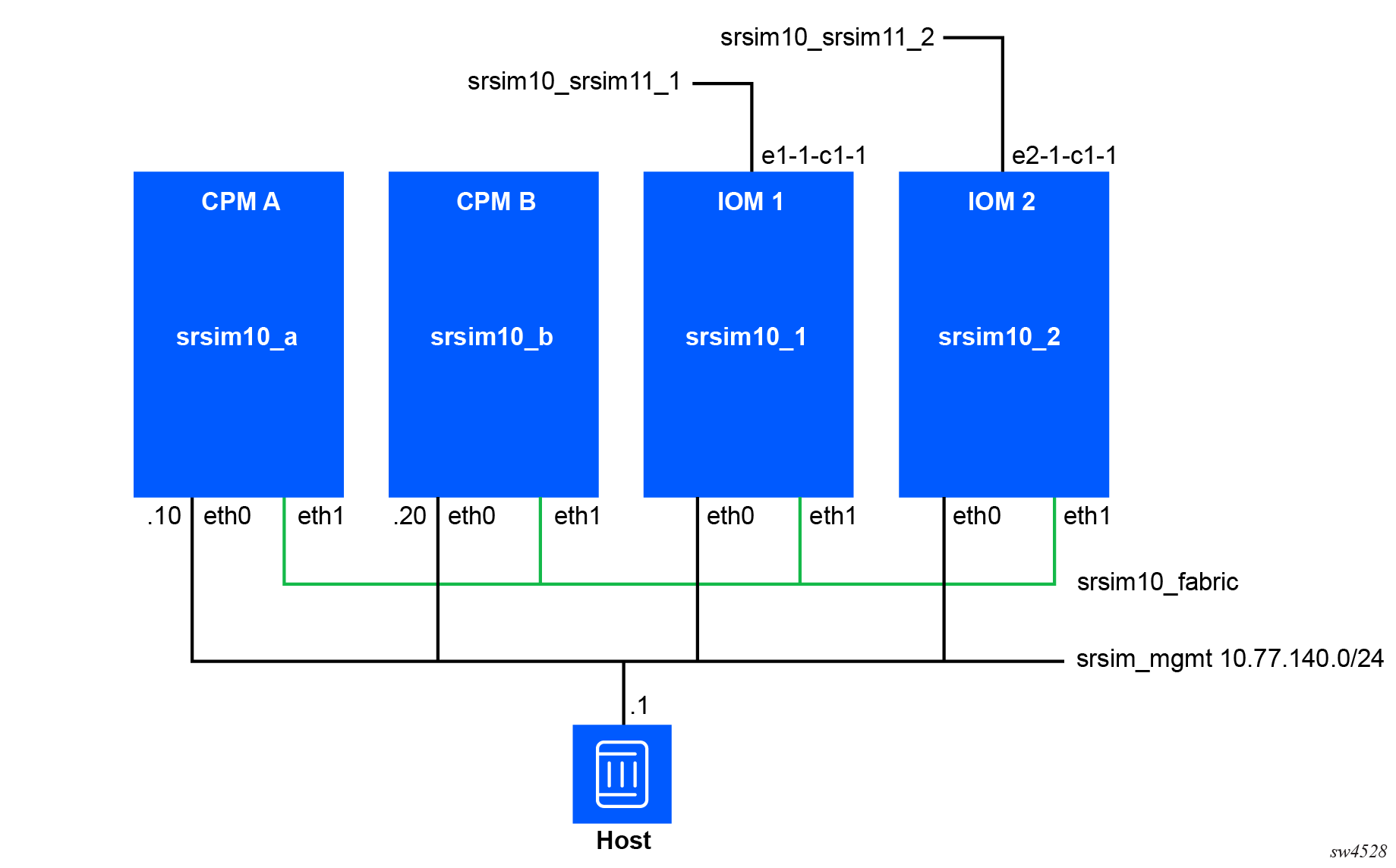
Each container has a management connection, which is also the
first interface in the container. The primary and standby CPM must have an assigned IP
address on the management network. On both CPMs, the
NOKIA_SROS_ADDRESS_IPV4_ACTIVE environment variable should be set
to the chosen static IP address for the active CPM. This address is used for redundancy
switchover.
Each container needs to have a fabric interface to connect them
together. In the container layout example above, this is named
srsim10_fabric. No IP addressing is
required on this interface, it is a layer-2 bridge interface. By
ensuring this interface is named eth1 inside
the container it will be used as the fabric interface.
The datapath networks are attached to their specific linecards
and have interface names in the container that match the SR OS
interface naming format. For example, e2-1-c1-1 will be connected to
port 2/1/c1/1 in the srsim10_2 container (which is IOM
2).
The srsim_mgmt network has already been created.
The following commands create the two datapath networks
(srsim10_srsim11_1 and srsim10_srsim11_2) and the two fabric
networks used to interconnect the containers acting as device
linecards (srsim10_fabric and
srsim11_fabric).
docker network create srsim10_srsim11_1
docker network create srsim10_srsim11_2
docker network create srsim10_fabric
docker network create srsim11_fabricUse the following commands to create the eight containers required to deploy two 7750 SR-7 simulated devices using the SR-SIM in distributed mode.
docker run --privileged --rm --name srsim10_a -d \
--network srsim_mgmt --ip 10.77.140.10 \
--network=name=srsim10_fabric,driver-opt=com.docker.network.endpoint.ifname=eth1 \
-e NOKIA_SROS_CHASSIS=sr-7 \
-e NOKIA_SROS_SLOT=a \
-e NOKIA_SROS_SYSTEM_BASE_MAC=de:ff:ab:c9:bb:aa \
-e NOKIA_SROS_ADDRESS_IPV4_ACTIVE=10.77.140.10/24 \
-v /tmp/license.txt:/nokia/license/license.txt \
-v ./srsim10.cfg:/nokia/config/config.cfg \
localhost:32000/srsim:25.10.R1
docker run --privileged --rm --name srsim10_b -d \
--network srsim_mgmt --ip 10.77.140.20 \
--network=name=srsim10_fabric,driver-opt=com.docker.network.endpoint.ifname=eth1 \
-e NOKIA_SROS_CHASSIS=sr-7 \
-e NOKIA_SROS_SLOT=b \
-e NOKIA_SROS_SYSTEM_BASE_MAC=de:ff:ab:c9:bb:aa \
-e NOKIA_SROS_ADDRESS_IPV4_ACTIVE=10.77.140.10/24 \
-v /tmp/license.txt:/nokia/license/license.txt \
-v ./srsim10.cfg:/nokia/config/config.cfg \
localhost:32000/srsim:25.10.R1
docker run --privileged --rm --name srsim10_1 -d \
--network srsim_mgmt \
--network=name=srsim10_fabric,driver-opt=com.docker.network.endpoint.ifname=eth1 \
--network=name=srsim10_srsim11_1,driver-opt=com.docker.network.endpoint.ifname=e1-1-c1-1 \
-e NOKIA_SROS_CHASSIS=sr-7 \
-e NOKIA_SROS_SLOT=1 \
-v /tmp/license.txt:/nokia/license/license.txt \
localhost:32000/srsim:25.10.R1
docker run --privileged --rm --name srsim10_2 -d \
--network srsim_mgmt \
--network=name=srsim10_fabric,driver-opt=com.docker.network.endpoint.ifname=eth1 \
--network=name=srsim10_srsim11_2,driver-opt=com.docker.network.endpoint.ifname=e2-1-c1-1 \
-e NOKIA_SROS_CHASSIS=sr-7 \
-e NOKIA_SROS_SLOT=2 \
-v /tmp/license.txt:/nokia/license/license.txt \
localhost:32000/srsim:25.10.R1
docker run --privileged --rm --name srsim11_a -d \
--network srsim_mgmt --ip 10.77.140.11 \
--network=name=srsim11_fabric,driver-opt=com.docker.network.endpoint.ifname=eth1 \
-e NOKIA_SROS_CHASSIS=sr-7 \
-e NOKIA_SROS_SLOT=a \
-e NOKIA_SROS_SYSTEM_BASE_MAC=de:ff:ab:c9:bb:bb \
-e NOKIA_SROS_ADDRESS_IPV4_ACTIVE=10.77.140.11/24 \
-v /tmp/license.txt:/nokia/license/license.txt \
-v ./srsim11.cfg:/nokia/config/config.cfg \
localhost:32000/srsim:25.10.R1
docker run --privileged --rm --name srsim11_b -d \
--network srsim_mgmt --ip 10.77.140.21 \
--network=name=srsim11_fabric,driver-opt=com.docker.network.endpoint.ifname=eth1 \
-e NOKIA_SROS_CHASSIS=sr-7 \
-e NOKIA_SROS_SLOT=b \
-e NOKIA_SROS_SYSTEM_BASE_MAC=de:ff:ab:c9:bb:bb \
-e NOKIA_SROS_ADDRESS_IPV4_ACTIVE=10.77.140.11/24 \
-v /tmp/license.txt:/nokia/license/license.txt \
-v ./srsim11.cfg:/nokia/config/config.cfg \
localhost:32000/srsim:25.10.R1
docker run --privileged --rm --name srsim11_1 -d \
--network srsim_mgmt \
--network=name=srsim11_fabric,driver-opt=com.docker.network.endpoint.ifname=eth1 \
--network=name=srsim10_srsim11_1,driver-opt=com.docker.network.endpoint.ifname=e1-1-c1-1 \
-e NOKIA_SROS_CHASSIS=sr-7 \
-e NOKIA_SROS_SLOT=1 \
-v /tmp/license.txt:/nokia/license/license.txt \
localhost:32000/srsim:25.10.R1
docker run --privileged --rm --name srsim11_2 -d \
--network srsim_mgmt \
--network=name=srsim11_fabric,driver-opt=com.docker.network.endpoint.ifname=eth1 \
--network=name=srsim10_srsim11_2,driver-opt=com.docker.network.endpoint.ifname=e2-1-c1-1 \
-e NOKIA_SROS_CHASSIS=sr-7 \
-e NOKIA_SROS_SLOT=2 \
-v /tmp/license.txt:/nokia/license/license.txt \
localhost:32000/srsim:25.10.R1 The containers are named
srsim<number>_<slot_number> to clearly identify which
containers are performing. The container names also clearly indicate their functional
role on the applicable router.
Use the following commands to stop the containers and remove all networks.
docker container stop srsim10_a srsim10_b srsim10_1 srsim10_2 srsim11_a srsim11_b srsim11_1 srsim11_2
docker network rm srsim_mgmt srsim10_fabric srsim11_fabric srsim10_srsim11_1 srsim10_srsim11_2Docker compose
Docker compose extends the provisioning options available with Docker to a single provisioning
manifest. This manifest is named docker-compose.yml and defines the
deployment of one (or more) SR-SIM
instances (in either integrated or distributed mode) in terms of containers (referred to as
services in Docker compose), networks, and storage
(referred to as volumes in Docker compose).
docker-compose.yml manifest, navigate to the directory where the file is
located and run the docker compose command.localhost:32000/srsim:25.10.R1.Integrated
The following figure shows an example manifest to provision a network comprising two SR-SIM instances connected using bridge interfaces.
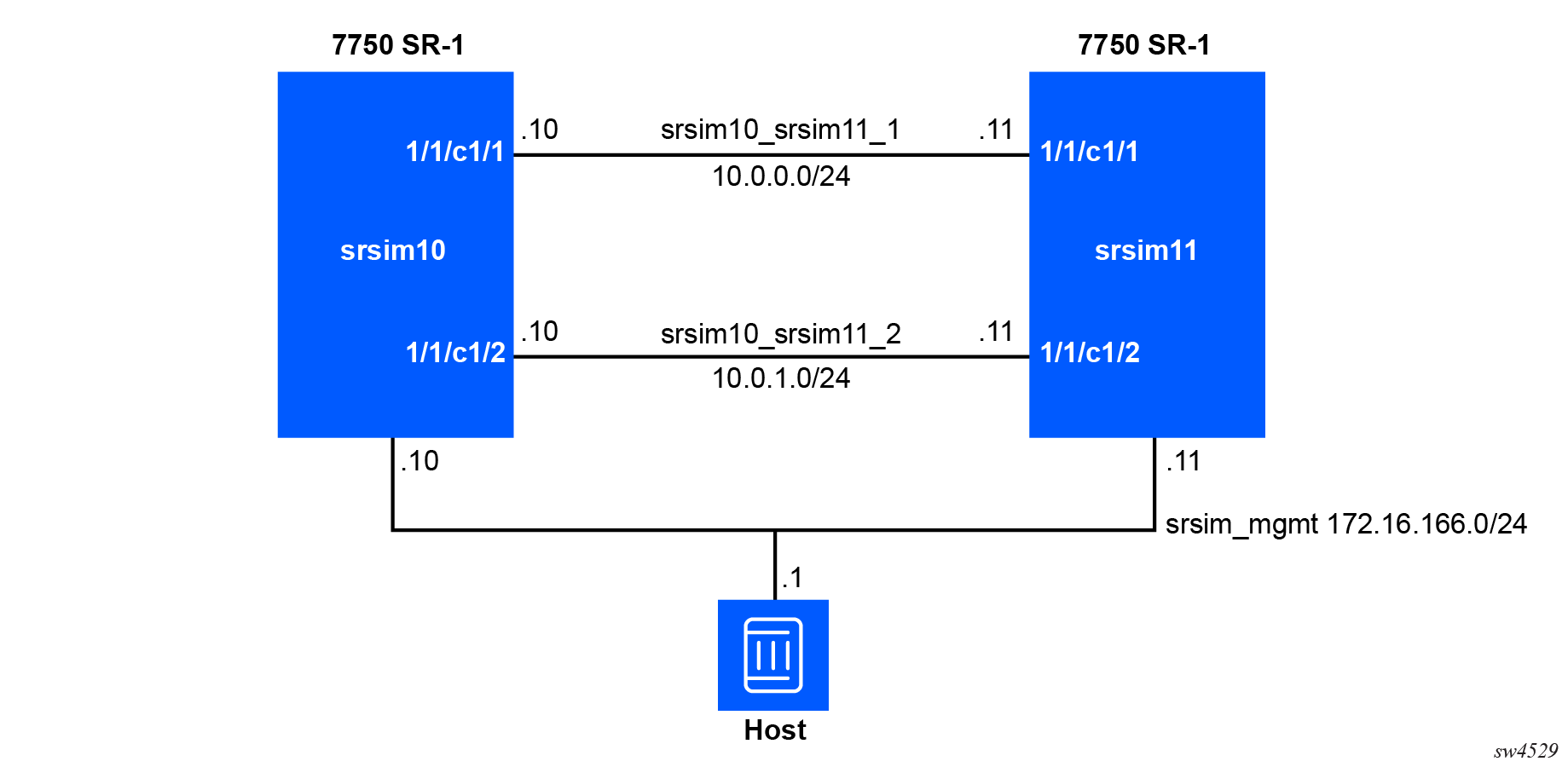
The following docker-compose.yml manifest is used to
deploy these two SR-SIM
instances and the network connectivity between them.
services:
srsim10:
image: localhost:32000/srsim:25.10.R1
privileged: true
volumes:
- /tmp/license.txt:/nokia/license/license.txt
- ./srsim10.cfg:/nokia/config/config.cfg
networks:
srsim_mgmt:
ipv4_address: 172.16.166.10
srsim10_srsim11_1:
interface_name: e1-1-c1-1
srsim10_srsim11_2:
interface_name: e1-1-c1-2
srsim11:
image: localhost:32000/srsim:25.10.R1
privileged: true
volumes:
- /tmp/license.txt:/nokia/license/license.txt
- ./srsim11.cfg:/nokia/config/config.cfg
networks:
srsim_mgmt:
ipv4_address: 172.16.166.11
srsim10_srsim11_1:
interface_name: e1-1-c1-1
srsim10_srsim11_2:
interface_name: e1-1-c1-2
networks:
srsim_mgmt:
driver: bridge
driver_opts:
com.docker.network.driver.mtu: "9000"
com.docker.network.bridge.name: "srsim_mgmt"
ipam:
driver: default
config:
- subnet: 172.16.166.0/24
gateway: 172.16.166.1
srsim10_srsim11_1:
srsim10_srsim11_2:This section provides detailed description of the key sections of this manifest.
networks:
srsim_mgmt:
driver: bridge
driver_opts:
com.docker.network.driver.mtu: "9000"
com.docker.network.bridge.name: "srsim_mgmt"
ipam:
driver: default
config:
- subnet: 172.16.166.0/24
gateway: 172.16.166.1
srsim10_srsim11_1:
srsim10_srsim11_2:This part of the manifest creates three networks. Networks are
created within the networks top-level section of the manifest. The first
network is called srsim_mgmt. This network is a bridge network that will
create the srsim_mgmt network on the host machine with the MTU set to
9000. The srsim_mgmt bridge interface will be deployed
with the 172.16.166.0/24 subnet assigned to it, from which Docker will
allocate IP addresses to containers that join this network (either dynamically [by default] or
statically as shown in this example). When the deployment is removed, this interface will
remain on the host unless the following command is issued manually sudo ifconfig
srsim_mgmt down.
The other two networks, srsim10_srsim11_1 and
srsim10_srsim11_2, are internal Docker networks. They are created
within Docker and are not visible on the host machine once the deployment is removed. In
this example, each link is created as its own network, which can also be deployed as a
single shared broadcast network. Although it is not described in this section, when
these networks are applied to the containers (SR-SIM
instances), additional configuration will be applied.
The services section of the manifest describes the
containers that will be created. In the following section, a single
example srsim10 container is considered.
services:
srsim10:
image: localhost:32000/srsim:25.10.R1
privileged: true
volumes:
- /tmp/license.txt:/nokia/license/license.txt
- ./srsim10.cfg:/nokia/config/config.cfg
networks:
srsim_mgmt:
ipv4_address: 172.16.166.10
srsim10_srsim11_1:
interface_name: e1-1-c1-1
srsim10_srsim11_2:
interface_name: e1-1-c1-2The preceding service (SR-SIM container) comprises the following component parts:
The container name is the name of the service specified in the Docker compose manifest. In this example, the container will be named
srsim10.The
imagestatement specifies the source location of the SR-SIM software image. In this example, thelocalhost:32000/srsim:25.10.R1software image will be used.The
privileged: trueline grants the container additional permissions on the host machine, allowing it to manipulate the networking interfaces.The
volumessection defines how files and directories are mounted inside the container. Two files are mounted in this example: the license file and the router configuration file. The SR-SIM will not boot without a valid license file. If the configuration file is not provided, the SR OSSR OS default configuration is used.- The
/tmp/license.txt:/nokia/license/license.txtshould be treated assource:destination. This line mounts the local/tmp/license.txtfile inside the container as/nokia/license/license.txt. - The
./srsim10.cfg:/nokia/config/config.cfgline mounts thesrsim10.cfgin the same directory as thedocker-compose.ymlfile inside the container as/nokia/config/config.cfg.
- The
The
networkssection defines the network interfaces for the container. Within each container, this section references the networks defined in the top-levelnetworkssection. The order in which these networks are used defines the order (and name) of the interfaces inside the container.- The
srsim_mgmtentry adds the previously definedsrsim_mgmtbridge network. Theipv4_addressentry assigns a static IPv4 address to the network interface inside the container. This static IP address must be within the subnet defined in the bridge network definition. As thesrsim_mgmtis defined first, it is attached inside the container as theeth0network interface. - The
srsim10_srsim11_1network is attached next into the container, with the interface namee1-1-c1-1. The name assigned to the network interface is crucial, as the SR-SIM uses this name to determine where to attach the networks inside SR OS. In this example, thesrsim10_srsim11_1network is attached into the container as thee1-1-c1-1interface, and SR OS knows that this interface is attached to port1/1/c1/1.
- The
Use the docker compose command to deploy the
manifest. The preferred method of deployment is to start the containers and run them in
the background. The docker compose up -d command deploys the network
described in the preceding example, allowing it to run in the background.
Use the docker compose down --remove-orphans command
to destroy (undeploy) the network, and remove containers and
associated networking. The --remove-orphans flag is
optional, but useful to remove unused or stale Docker containers,
networks, or volumes from the system.
Distributed
In the distributed mode, each linecard of each router requires its own container. The following
figure shows the network diagram for this docker-compose.yml manifest.
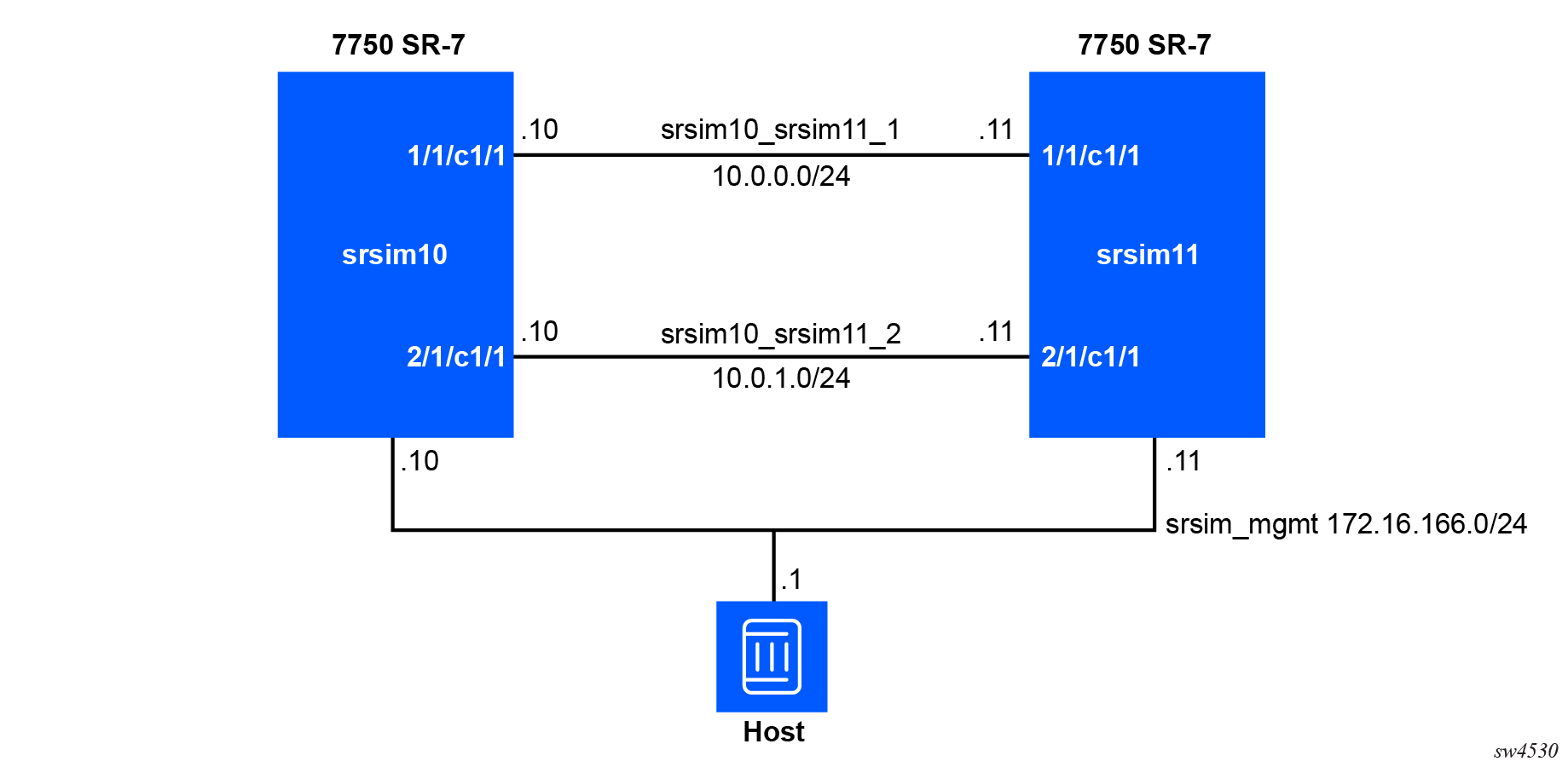
Each router consists of a number of containers. The following figure
shows an example srsim10 router container layout,
where each box represents a separate container.
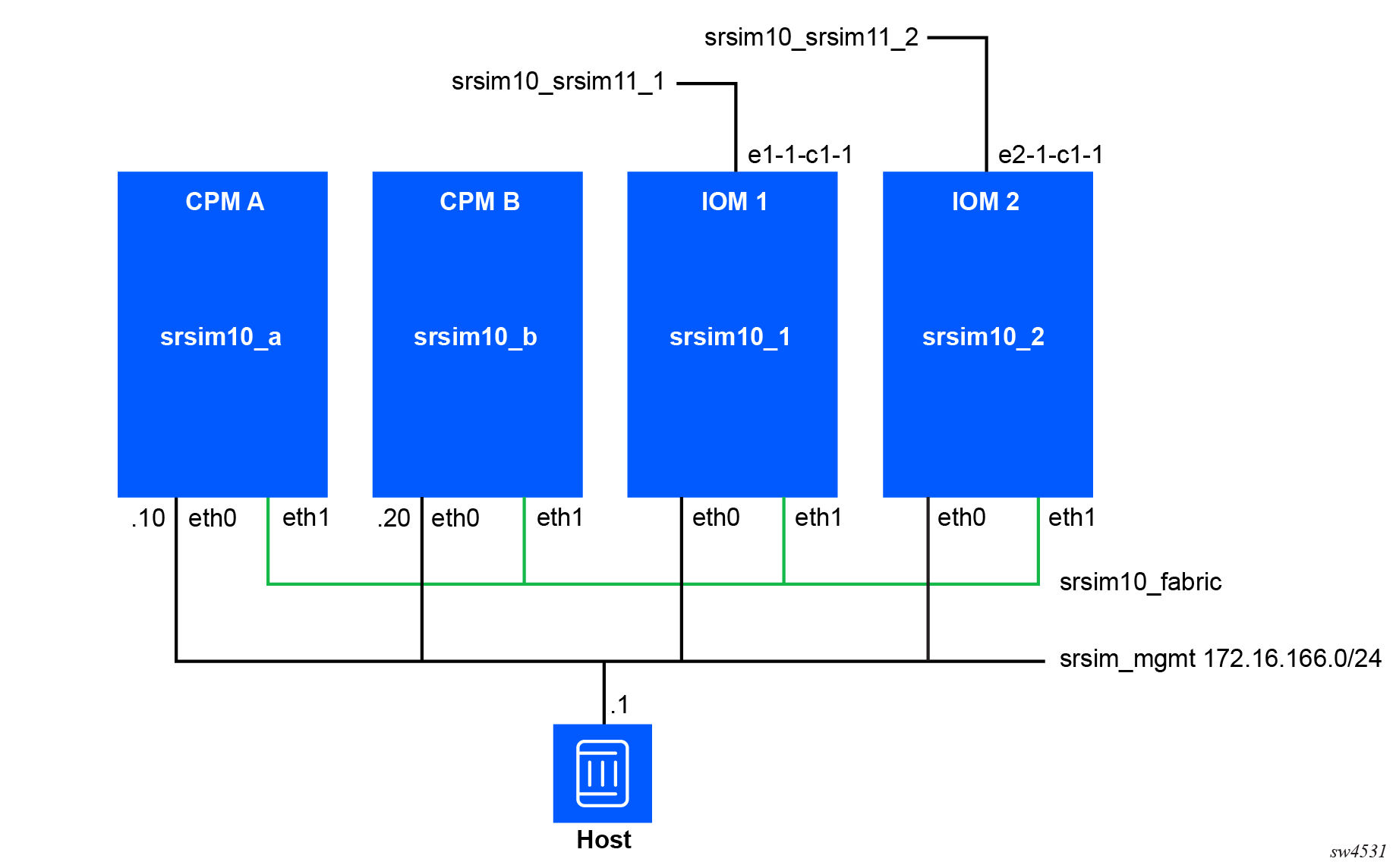
Each container has a management connection, which is also the first
interface in the container. It is required to have an IP address on
the management network for the primary CPM and standby CPM. On both
the active and standby CPM, the
NOKIA_SROS_ADDRESS_IPV4_ACTIVE environment
variable should be set to the chosen static IP address for the
active CPM. This address is used for redundancy switchover.
Each container requires a fabric interface to connect them together.
In the preceding container layout example, this interface is named
srsim10_fabric. No IP addressing is required
because it is a layer-2 bridge interface. Ensure that this interface
is named eth1 inside the container, which
designates it as the fabric interface.
The datapath networks are attached to their specific linecards and
the interface names within the container that follow the SR OS
interface naming format. For example, e2-1-c1-1
will be connected to port 2/1/c1/1 in the
srsim10_2 container (which is IOM 2).
The following is an example manifest to provision the network comprising two SR-SIM instances connected together using bridge interfaces.
services:
srsim10_a:
image: localhost:32000/srsim:25.10.R1
privileged: true
volumes:
- /tmp/license.txt:/nokia/license/license.txt
- ./srsim10.cfg:/nokia/config/config.cfg
environment:
- NOKIA_SROS_CHASSIS=sr-7
- NOKIA_SROS_SLOT=a
- NOKIA_SROS_SYSTEM_BASE_MAC=de:ff:ab:c9:bb:aa
- NOKIA_SROS_ADDRESS_IPV4_ACTIVE=172.16.166.10/24
networks:
srsim_mgmt:
ipv4_address: 172.16.166.10
srsim10_fabric:
interface_name: eth1
srsim10_b:
image: localhost:32000/srsim:25.10.R1
privileged: true
volumes:
- /tmp/license.txt:/nokia/license/license.txt
- ./srsim10.cfg:/nokia/config/config.cfg
environment:
- NOKIA_SROS_CHASSIS=sr-7
- NOKIA_SROS_SLOT=b
- NOKIA_SROS_SYSTEM_BASE_MAC=de:ff:ab:c9:bb:aa
- NOKIA_SROS_ADDRESS_IPV4_ACTIVE=172.16.166.10/24
networks:
srsim_mgmt:
ipv4_address: 172.16.166.20
srsim10_fabric:
interface_name: eth1
srsim10_1:
image: localhost:32000/srsim:25.10.R1
privileged: true
volumes:
- /tmp/license.txt:/nokia/license/license.txt
environment:
- NOKIA_SROS_CHASSIS=sr-7
- NOKIA_SROS_SLOT=1
networks:
srsim_mgmt:
srsim10_fabric:
interface_name: eth1
srsim10_srsim11_1:
interface_name: e1-1-c1-1
srsim10_2:
image: localhost:32000/srsim:25.10.R1
privileged: true
volumes:
- /tmp/license.txt:/nokia/license/license.txt
environment:
- NOKIA_SROS_CHASSIS=sr-7
- NOKIA_SROS_SLOT=2
networks:
srsim_mgmt:
srsim10_fabric:
interface_name: eth1
srsim10_srsim11_2:
interface_name: e2-1-c1-1
srsim11_a:
image: localhost:32000/srsim:25.10.R1
privileged: true
volumes:
- /tmp/license.txt:/nokia/license/license.txt
- ./srsim11.cfg:/nokia/config/config.cfg
environment:
- NOKIA_SROS_CHASSIS=sr-7
- NOKIA_SROS_SLOT=a
- NOKIA_SROS_SYSTEM_BASE_MAC=de:ff:ab:c9:bb:bb
- NOKIA_SROS_ADDRESS_IPV4_ACTIVE=172.16.166.11/24
networks:
srsim_mgmt:
ipv4_address: 172.16.166.11
srsim11_fabric:
interface_name: eth1
srsim11_b:
image: localhost:32000/srsim:25.10.R1
privileged: true
volumes:
- /tmp/license.txt:/nokia/license/license.txt
- ./srsim11.cfg:/nokia/config/config.cfg
environment:
- NOKIA_SROS_CHASSIS=sr-7
- NOKIA_SROS_SLOT=b
- NOKIA_SROS_SYSTEM_BASE_MAC=de:ff:ab:c9:bb:bb
- NOKIA_SROS_ADDRESS_IPV4_ACTIVE=172.16.166.11/24
networks:
srsim_mgmt:
ipv4_address: 172.16.166.21
srsim11_fabric:
interface_name: eth1
srsim11_1:
image: localhost:32000/srsim:25.10.R1
privileged: true
volumes:
- /tmp/license.txt:/nokia/license/license.txt
environment:
- NOKIA_SROS_CHASSIS=sr-7
- NOKIA_SROS_SLOT=1
networks:
srsim_mgmt:
srsim11_fabric:
interface_name: eth1
srsim10_srsim11_1:
interface_name: e1-1-c1-1
srsim11_2:
image: localhost:32000/srsim:25.10.R1
privileged: true
volumes:
- /tmp/license.txt:/nokia/license/license.txt
environment:
- NOKIA_SROS_CHASSIS=sr-7
- NOKIA_SROS_SLOT=2
networks:
srsim_mgmt:
srsim11_fabric:
interface_name: eth1
srsim10_srsim11_2:
interface_name: e2-1-c1-1
networks:
srsim_mgmt:
driver: bridge
driver_opts:
com.docker.network.driver.mtu: "9000"
com.docker.network.bridge.name: "srsim_mgmt"
ipam:
driver: default
config:
- subnet: 172.16.166.0/24
gateway: 172.16.166.1
srsim10_srsim11_1:
srsim10_srsim11_2:
srsim10_fabric:
srsim11_fabric:See the Integrated section for a detailed
explanation of the docker-compose.yml manifest. In addition to the details
used in that manifest, the following specific items are required to create the two SR-SIM
instances in integrated mode (as 7750 SR-7 routers in this example).
In the networks top-level section, define a separate
fabric network for each router. In this example, the
srsim10_fabric and
srsim11_fabric networks are defined.
The srsim_mgmt host bridge network and the networks
to interconnect the routers (srsim10_srsim11_1 and
srsim10_srsim11_2) remain the same as shown in
the integrated mode example manifest.
The following is an example of the CPM definitions (using the
srsim10).
services:
srsim10_a:
image: localhost:32000/srsim:25.10.R1
privileged: true
volumes:
- /tmp/license.txt:/nokia/license/license.txt
- ./srsim10.cfg:/nokia/config/config.cfg
environment:
- NOKIA_SROS_CHASSIS=sr-7
- NOKIA_SROS_SLOT=a
- NOKIA_SROS_SYSTEM_BASE_MAC=de:ff:ab:c9:bb:aa
- NOKIA_SROS_ADDRESS_IPV4_ACTIVE=172.16.166.10/24
networks:
srsim_mgmt:
ipv4_address: 172.16.166.10
srsim10_fabric:
interface_name: eth1
srsim10_b:
image: localhost:32000/srsim:25.10.R1
privileged: true
volumes:
- /tmp/license.txt:/nokia/license/license.txt
- ./srsim10.cfg:/nokia/config/config.cfg
environment:
- NOKIA_SROS_CHASSIS=sr-7
- NOKIA_SROS_SLOT=b
- NOKIA_SROS_SYSTEM_BASE_MAC=de:ff:ab:c9:bb:aa
- NOKIA_SROS_ADDRESS_IPV4_ACTIVE=172.16.166.10/24
networks:
srsim_mgmt:
ipv4_address: 172.16.166.20
srsim10_fabric:
interface_name: eth1The definitions now include environment variables. These environment variables are used to inform SR OS of specific provisioning requirements. In this case, each CPM defines the following:
- The router chassis type using the
NOKIA_SROS_CHASSISoption, setting it tosr-7to tell the SR-SIM to mimic the 7750 SR-7. - The slot number (or letter), the two CPM are provisioned as slot
aand slotbrespectively using theNOKIA_SROS_SLOTenvironment variable. - In a dual CPM system, each CPM must have a system MAC address
that is statically defined using the
NOKIA_SROS_SYSTEM_BASE_MACenvironment variable. This ensures that both CPMs act as a single redundant pair for the same router. - The IP address of the active CPM must be provisioned into both
SR OS CPMs using the
NOKIA_SROS_ADDRESS_IPV4_ACTIVEenvironment variable.Note: This variable requires an IP address value in CIDR notation (for example,172.16.166.10/24).
Looking at the IOM definitions (still using srsim10
as the example) as shown.
srsim10_1:
image: localhost:32000/srsim:25.10.R1
privileged: true
volumes:
- /tmp/license.txt:/nokia/license/license.txt
environment:
- NOKIA_SROS_CHASSIS=sr-7
- NOKIA_SROS_SLOT=1
networks:
srsim_mgmt:
srsim10_fabric:
interface_name: eth1
srsim10_srsim11_1:
interface_name: e1-1-c1-1
srsim10_2:
image: localhost:32000/srsim:25.10.R1
privileged: true
volumes:
- /tmp/license.txt:/nokia/license/license.txt
environment:
- NOKIA_SROS_CHASSIS=sr-7
- NOKIA_SROS_SLOT=2
networks:
srsim_mgmt:
srsim10_fabric:
interface_name: eth1
srsim10_srsim11_2:
interface_name: e2-1-c1-1There are now specific containers for each datapath linecard
(1 and 2 in this example), and
each of these use the NOKIA_SROS_SLOT environment
variable to inform SR OS of their position in the system.
Each datapath container also has a connection to the management network as its first interface, but without a statically assigned IP address. Docker automatically assigns an IP address to each container. However, as this address is not used to establish an SSH connection to the linecard, it is not relevant to the user.
Each container connects to the required fabric Docker network
srsim10_fabric as the eth1
interface, ensuring the SR OS uses it as the fabric interface.
As in the integrated mode, the datapath interfaces are automatically
bound to SR OS ports if they are attached into the containers with
the correct naming convention. In this example, each linecard has a
single datapath interface. Specifically, IOM 1 has the
e1-1-c1-1 interface, which will be bound to the
1/1/c1/1 port, and IOM 2 has the
e2-1-c1-1 interface, which will be bound to the
2/1/c1/1 port.
Deploy the manifest using the docker compose
command. The preferred method of deployment is to start the containers and run them in the
background. Use the docker compose up -d command to deploy the network
described in the preceding example, allowing it to run in the background.
Use the docker compose down --remove-orphans command
to destroy (undeploy) the network, and remove the containers and
associated networking. The --remove-orphans flag is
optional, but useful to clean up any unused or stale Docker
containers, networks, or volumes on the system.
Containerlab
Containerlab is a modern lab management solution for network engineers. It simplifies the creation of multi-vendor labs from a simple command-line tool. For information about Containerlab and the use of SR-SIM with it, review the containerlab documentation.
SR-SIM is
supported on Containerlab using the nokia_srsim kind. Customization of the
SR-SIM
instances within Containerlab is achieved using the environment variables described in this
document.
Containerlab supports the use of complete or partial configurations at startup with the SR-SIM.
Containerlab supports both integrated and distributed deployment models for the SR-SIM.
Integrated
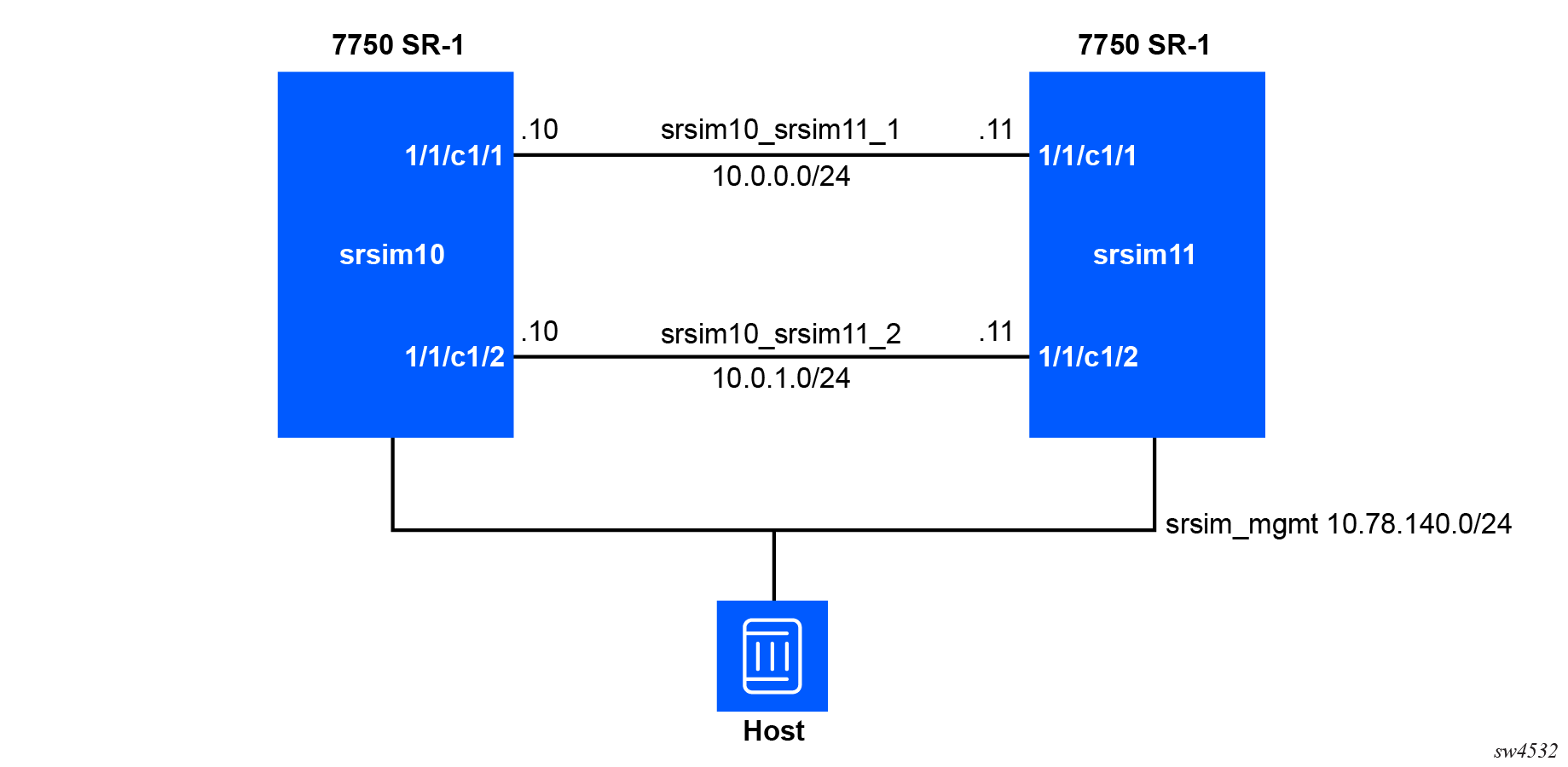
To deploy the preceding network in Containerlab, create the
Containerlab topology file. In this example, the file is named
srsim.clab.yml.
srsim.clab.yml:
name: "srsrim"
mgmt:
network: srsim_mgmt
ipv4-subnet: 10.78.140.0/24
topology:
kinds:
nokia_srsim:
license: /tmp/license.txt
image: localhost:32000/srsim:25.10.R1
nodes:
srsim10:
kind: nokia_srsim
type: SR-1 # Implicit default
startup-config: srsim10.partial.cfg # Example partial config
srsim11:
kind: nokia_srsim
startup-config: srsim11.cfg # Example complete config
links:
# Datapath interfaces
- endpoints: ["srsim10:e1-1-c1-1", "srsim11:e1-1-c1-1"]
- endpoints: ["srsim10:e1-1-c1-2", "srsim11:e1-1-c1-2"] To deploy this lab, use the containerlab or
clab command.
clab deploy -t srsim.clab.ymlWhen the nodes are booted and connected, output similar to the following is displayed:
╭─────────────────────┬────────────────────────────────┬─────────┬────────────────╮
│ Name │ Kind/Image │ State │ IPv4/6 Address │
├─────────────────────┼────────────────────────────────┼─────────┼────────────────┤
│ clab-srsrim-srsim10 │ nokia_srsim │ running │ 10.78.140.2 │
│ │ localhost:32000/srsim:25.10.R1 │ │ N/A │
├─────────────────────┼────────────────────────────────┼─────────┼────────────────┤
│ clab-srsrim-srsim11 │ nokia_srsim │ running │ 10.78.140.3 │
│ │ localhost:32000/srsim:25.10.R1 │ │ N/A │
╰─────────────────────┴────────────────────────────────┴─────────┴────────────────╯To remove the deployed network, use the following command.
clab destroy -t srsim.clab.ymlThe output displayed is similar to following:
22:32:23 INFO Parsing & checking topology file=srsim.clab.yml
22:32:23 INFO Parsing & checking topology file=srsim.clab.yml
22:32:23 INFO Destroying lab name=srsrim
22:32:24 INFO Removed container name=clab-srsrim-srsim10
22:32:24 INFO Removed container name=clab-srsrim-srsim11
22:32:24 INFO Removing host entries path=/etc/hosts
22:32:24 INFO Removing SSH config path=/etc/ssh/ssh_config.d/clab-srsrim.confTo also remove the filesystems created by the router instances, use
the --cleanup option.
Distributed
The following figure shows an example Containerlab topology file to provision a network comprising two SR-SIM instances connected using bridge interfaces.
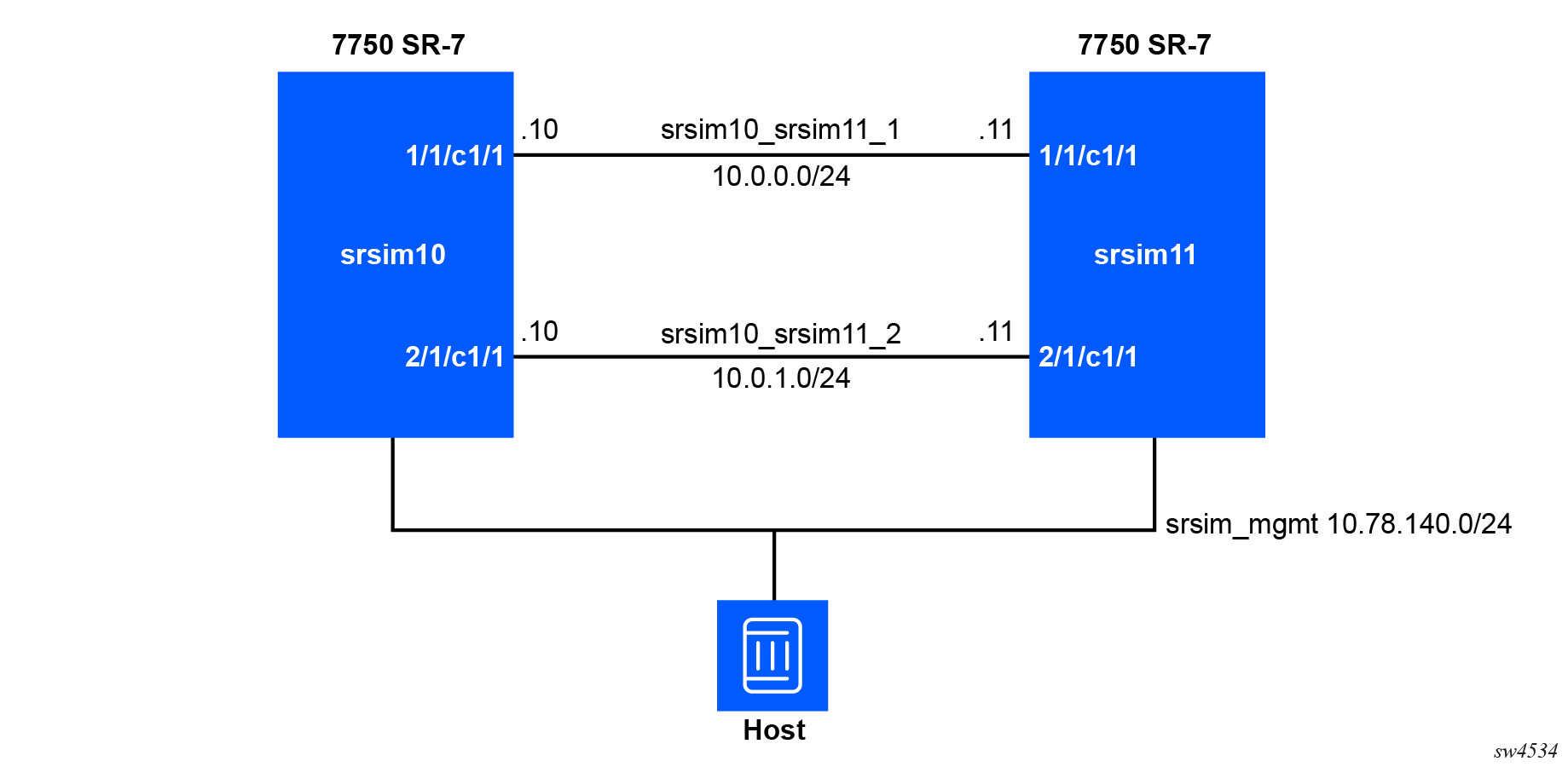
Each router consists of a number of containers. The following figure
shows an example srsim10 router container layout,
where each box represents a separate container. In Containerlab, it
is important to ensure that all containers in a distributed mode
deployment are configured to share the same network namespace. This
is achieved using the network_mode option.
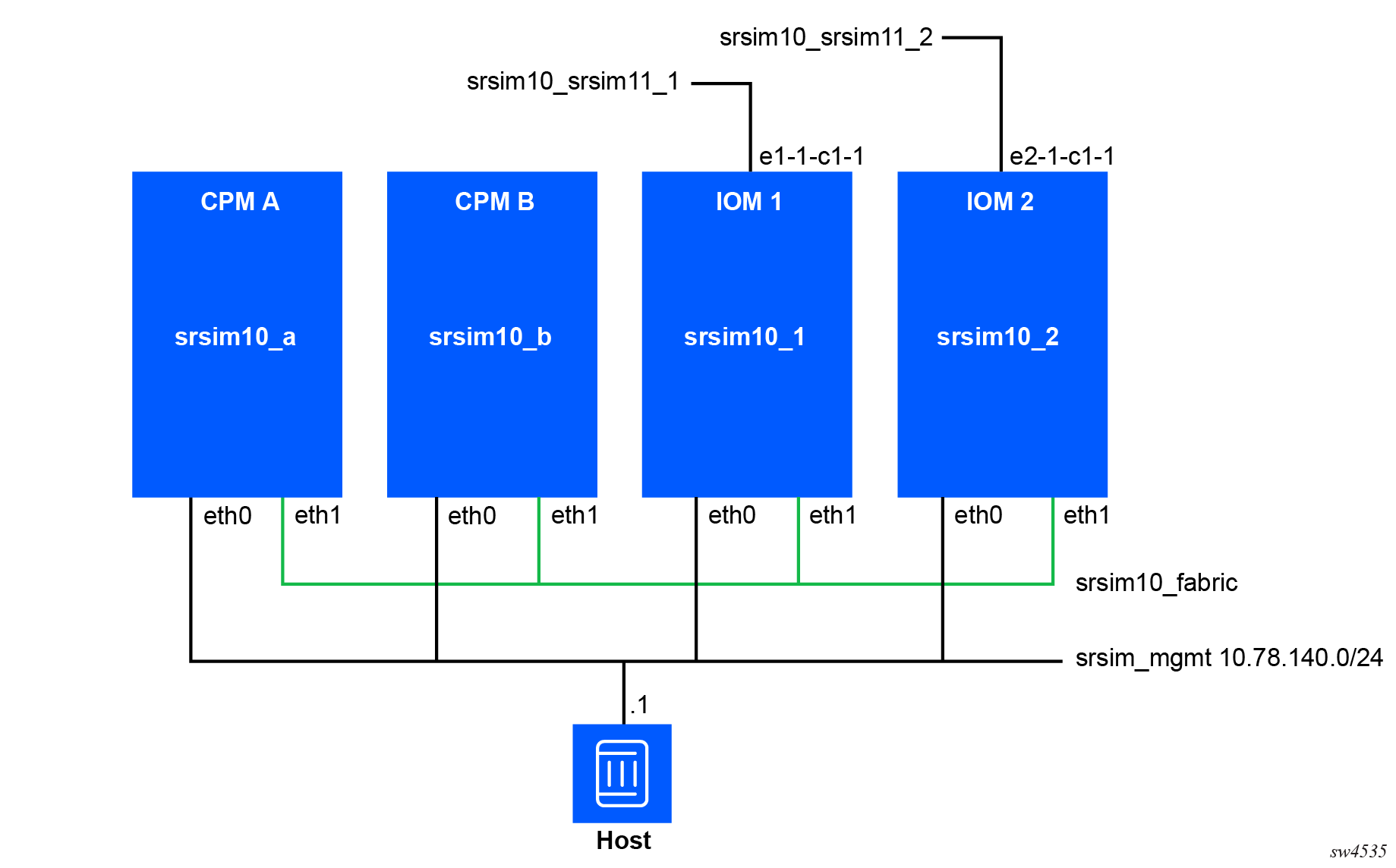
To deploy the preceding network in Containerlab, create the
Containerlab topology file. In this example, the file is named
srsim.clab.yml.
name: "srsrim"
mgmt:
network: srsim_mgmt
ipv4-subnet: 10.78.140.0/24
topology:
kinds:
nokia_srsim:
license: /tmp/license.txt
image: localhost:32000/srsim:25.10.R1
nodes:
srsim10_fabric:
kind: bridge
srsim11_fabric:
kind: bridge
# srsim10
srsim10-a:
kind: nokia_srsim
type: SR-7
env:
NOKIA_SROS_SLOT: A
NOKIA_SROS_SYSTEM_BASE_MAC: 1c:58:07:00:03:01
startup-config: srsim10.cfg
srsim10-b:
kind: nokia_srsim
type: SR-7
network-mode: container:srsim10-a
env:
NOKIA_SROS_SLOT: B
NOKIA_SROS_SYSTEM_BASE_MAC: 1c:58:07:00:03:01
startup-config: srsim10.cfg
srsim10-1:
kind: nokia_srsim
type: SR-7
network-mode: container:srsim10-a
env:
NOKIA_SROS_SLOT: 1
srsim10-2:
kind: nokia_srsim
type: SR-7
network-mode: container:srsim10-a
env:
NOKIA_SROS_SLOT: 2
# srsim11
srsim11-a:
kind: nokia_srsim
type: SR-7
env:
NOKIA_SROS_SLOT: A
NOKIA_SROS_SYSTEM_BASE_MAC: 1c:58:07:00:03:02
startup-config: srsim11.cfg
srsim11-b:
kind: nokia_srsim
type: SR-7
network-mode: container:srsim11-a
env:
NOKIA_SROS_SLOT: B
NOKIA_SROS_SYSTEM_BASE_MAC: 1c:58:07:00:03:02
startup-config: srsim11.cfg
srsim11-1:
kind: nokia_srsim
type: SR-7
network-mode: container:srsim11-a
env:
NOKIA_SROS_SLOT: 1
srsim11-2:
kind: nokia_srsim
type: SR-7
network-mode: container:srsim11-a
env:
NOKIA_SROS_SLOT: 2
links:
# Datapath links
- endpoints: ["srsim10-1:e1-1-c1-1", "srsim11-1:e1-1-c1-1"]
- endpoints: ["srsim10-2:e2-1-c1-1", "srsim11-2:e2-1-c2-1"]network-mode statement and setting its value to the name of the active
CPM container.To remove the deployed network, use the following command.
clab destroy -t srsim.clab.ymlThe displayed output is similar to the following:
22:30:11 INFO Parsing & checking topology file=srsim.clab.yml
22:30:11 INFO Parsing & checking topology file=srsim.clab.yml
22:30:11 INFO Destroying lab name=srsrim
22:30:11 INFO Removed container name=clab-srsrim-srsim10-a
22:30:13 INFO Removed container name=clab-srsrim-srsim11-b
22:30:13 INFO Removed container name=clab-srsrim-srsim10-b
22:30:13 INFO Removed container name=clab-srsrim-srsim10-2
22:30:13 INFO Removed container name=clab-srsrim-srsim11-2
22:30:13 INFO Removed container name=clab-srsrim-srsim11-1
22:30:13 INFO Removed container name=clab-srsrim-srsim10-1
22:30:13 INFO Removed container name=clab-srsrim-srsim11-a
22:30:13 INFO Removing host entries path=/etc/hosts
22:30:13 INFO Removing SSH config path=/etc/ssh/ssh_config.d/clab-srsrim.confTo also remove the filesystems created by the router instances, use
the --cleanup option.
Kubernetes
Kubernetes overview
Kubernetes is a container management platform that allows for the detailed management of large-scale compute clusters, with built-in scheduling and resiliency functionality. Kubernetes is designed to facilitate highly customizable application microservices that can scale vertically by increasing or decreasing memory and CPU resources dynamically, and horizontally by adding and removing container instances to meet the requirements of the overall application or service.
Kubernetes is a declarative system, meaning that the user instructs Kubernetes through the use of resource manifest files, specifying how the end system should look. The Kubernetes management system then determines how to reconcile the current state of the Kubernetes cluster to the desired (declared) state.
Deploying the SR-SIM on a Kubernetes cluster enables the creation of large-scale labs distributed over multiple compute nodes, optimizing the available infrastructure.
The following Kubernetes-specific terminology is used throughout this document:
- node: A physical compute machine (server).
- cluster: A Kubernetes cluster is a collection of nodes joined together to function as one pool of compute.
- container: The simplest building block within Kubernetes, referring to the actual software image running on the compute. A container creates an instance of the software from a given container registry.
- registry: A container registry is a storage environment
that contains copies of the physical software in a library that can be queried by
Kubernetes. When a container is started, it queries the registry for the software
image and then downloads the file. Registries may be public or private. Note: Nokia recommends using a private container registry; the SR-SIM image should not be stored in a publicly accessible registry.
- volume: A volume represents an element of data that can be presented to a container as a file within its filesystem. A volume may come from a file, a directory, or from other Kubernetes elements, such as ConfigMaps or Secrets.
- configmap: A ConfigMap is a set of constants that can be used with other Kubernetes elements. ConfigMaps can be created statically, or generated from Kustomization or files.
- secret: A secret is similar to a ConfigMap, but the stored data is encoded (obfuscated). Secrets are often used to store passwords.
- pod: A pod is an important element in Kubernetes. It is a collection of containers and volumes connected together to form a deployable instance. One SR-SIM can be considered to be delivered in one pod. A pod may contain multiple containers and volumes.
- deployment: A deployment is a logical grouping that provides the intended deployment of a pod. A deployment enables an implementation to scale horizontally to create and remove pod instances as required. The example in this document shows a Deployment as a method to instantiate the SR-SIM.
- service: When a Kubernetes pod is deployed, it does not have any external connectivity or internal cluster connectivity. By default, a pod cannot communicate with another pod, although containers within a pod can communicate with each other. A service exposes specific pods to customers and external entities. A service may expose ports locally on the host machine (not recommended), to the cluster itself (called ClusterIP), or to external entities via a Kubernetes load balancer (called LoadBalancerIP).
- cni: A Container Network Interface (CNI) is a plugin that enables connectivity between containers and between nodes in a Kubernetes cluster. There are many CNI available for Kubernetes. The choice of a CNI is important in the context of the SR-SIM, as the SR-SIM requires each container to be provided with an IP address within a routable range and a default route to a reachable IP address. Some CNI do not support this capability.
- network attachment definition: A network attachment definition is a declarative way of describing network interfaces used to connect pods.
- kustomize: Kustomize provides a way to automatically generate specific Kubernetes elements upon deployment. It also provides a convenient way to link a number of Kubernetes resources (elements) together to deploy them all at once. The examples in this document use Kustomize to instantiate SR-SIM laboratory networks.
- namespace: Kubernetes namespaces keep Kubernetes resources (elements) separated, ensuring security and reducing the blast radius of any failing deployments.
Kubernetes distributions
There are many Kubernetes distributions available. Common distributions include (but are not limited to):
License file
The SR-SIM
license file must be mounted in each SR-SIM
container as the /nokia/license/license.txt file. Kubernetes provides
several ways to achieve this, including Volumes, ConfigMaps, and Secrets.
Examples in this section use Kustomize to automatically generate ConfigMaps from the license file stored locally on disk. This approach eliminates the need to distribute the license file to hosts in the Kubernetes cluster.
SR OS configuration file
The SR OS configuration file may, optionally, be provided to a CPM container by mounting it as the /nokia/config/config.cfg file on the container filesystem. Kubernetes provides several ways to achieve this, including Volumes, ConfigMaps, and Secrets.
Examples in this section use Kustomize to automatically generate ConfigMaps from the license file stored locally on disk. This approach eliminates the need to distribute the license file to hosts in the Kubernetes cluster.
Kubernetes characteristics used in examples
The following examples are deployed on a k3s Kubernetes cluster running two Container Network
Interfaces (CNI): Flannel and Multus. Flannel provides simple networking for
the cluster and Multus provides inter-pod connectivity with
NetworkAttachmentDefinition resources. The cluster
is deployed using Ubuntu Linux version 24.04.
Integrated mode deployment
The following figure shows an example network comprising of two SR-SIM instances running in integrated mode. Each SR-SIM instance has a connection to the default Kubernetes management network and two connections to the other SR-SIM instance.
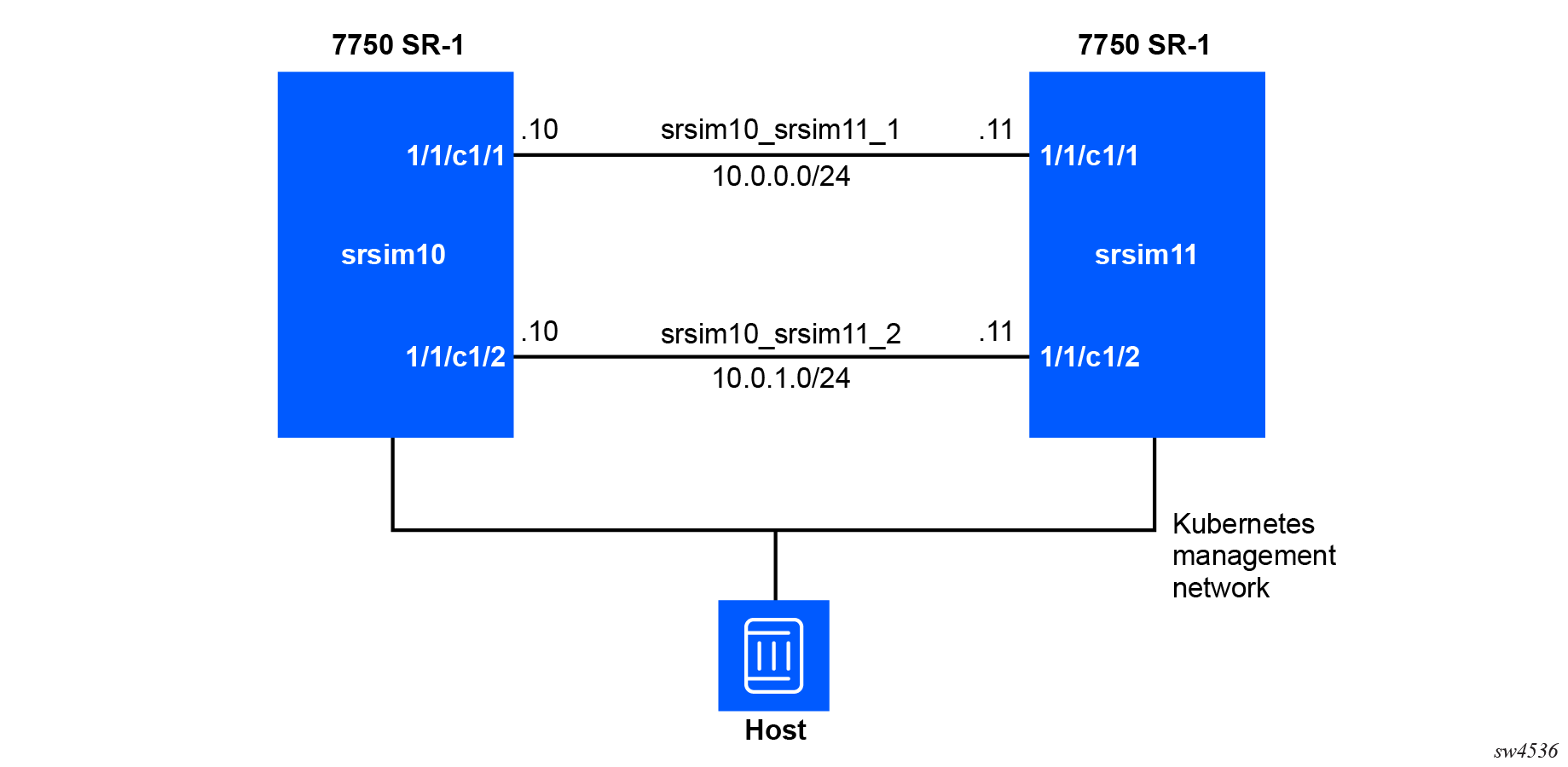
To create this network, deploy the following resources to the Kubernetes cluster:
- A
Namespacecalledsrsimthat will contain each of the Kubernetes resources, keeping them separate from any other workloads on the Kubernetes cluster - A
NetworkAttachmentDefinitionfor each of thesrsim10_srsim11_1andsrsim10_srsim11_2networks - A
ConfigMapcontaining the two SR OS configuration filessrsim10.cfgandsrsim11.cfg, along with the SR OS license filelicense.txt - A
Deploymentfor each SR-SIM instance (srsim10andsrsim11) - A
Servicefor each SR-SIM instance exposing the SSH port on each router
Each of these resources must be defined in YAML files and created and
deployed using Kustomize and the Kustomization manifest file
kustomization.yml.
Create a directory to store the manifest files. Navigate to make this your working directory for the rest of this deployment.
Create the namespace manifest file for the srsim
namespace.
srsim-namespace.yml:
kind: Namespace
apiVersion: v1
metadata:
name: srsim
labels:
name: srsimThis resource creates the srsim namespace, which
will contain all other resources in this example.
Create the NetworkAttachmentDefinition manifest
files for the srsim10_srsim11_1 and
srsim10_srsim11_2 networks.
srsim10_srsim11_1_nad.yml:
apiVersion: 'k8s.cni.cncf.io/v1'
kind: NetworkAttachmentDefinition
metadata:
name: srsim10-srsim11-1
spec:
config: '{
"cniVersion": "0.3.1",
"name": "srsim10_srsim11_1",
"type": "macvlan",
"mode": "bridge",
"mtu": 9000
}'srsim10_srsim11_2_nad.yml:
apiVersion: 'k8s.cni.cncf.io/v1'
kind: NetworkAttachmentDefinition
metadata:
name: srsim10-srsim11-2
spec:
config: '{
"cniVersion": "0.3.1",
"name": "srsim10_srsim11_2",
"type": "macvlan",
"mode": "bridge",
"mtu": 9000
}'These NetworkAttachmentDefinition resources are used
by the Multus CNI plugin to interconnect the SR-SIM
instances. The Multus CNI plugin is used because it allows the operator to attach
multiple network interfaces to a single container or pod.
In the preceding NetworkAttachmentDefinition, each
network is created as a MACVLAN network in bridge mode. The MTU on
each link is set at creation.
Create the Deployment manifest for the first SR-SIM
instance, srsim10.
srsim10-deployment.yml:
apiVersion: apps/v1
kind: Deployment
metadata:
name: srsim10
spec:
selector:
matchLabels:
app: srsim10
template:
metadata:
annotations:
k8s.v1.cni.cncf.io/networks: srsim10-srsim11-1@e1-1-c1-1, srsim10-srsim11-2@e1-1-c1-2
labels:
app: srsim10
spec:
volumes:
- name: files-vol
configMap:
name: files-configmap
items:
- key: license.txt
path: license.txt
- key: srsim10.cfg
path: srsim10.cfg
containers:
- name: srsim10
image: localhost:32000/srsim:25.10.R1
volumeMounts:
- name: files-vol
mountPath: /nokia/license/license.txt
subPath: license.txt
- name: files-vol
mountPath: /nokia/config/config.cfg
subPath: srsim10.cfg
securityContext:
privileged: trueThe component parts of this Deployment are as
follows:
name: srsim10: This line sets the name of the deployment. The names of the Pods created as a result will be prefixed with this value.k8s.v1.cni.cncf.io/networks: srsim10-srsim11-1@e1-1-c1-1, srsim10-srsim11-2@e1-1-c1-2: This line creates the datapath interfaces inside the container. There are two interfaces created betweensrsim10andsrsim11, as shown in the figure earlier in this section. Each interface created here is defined as<NetworkAttachmentDefinition name>@<Interface name inside the container>. The<NetworkAttachmentDefinition name>refers to the definition in the earlier manifests. One interface is added on the first bridge and the other on the second. The<Interface name inside the container>defines the name of the interface that will be created inside the container. This must use the matching format to align with the SR OS port names. For example,e1-1-c1-1will be connected to port1/1/c1/1in SR OS.- The
volumessection creates afiles-volvolume, which uses aConfigMapcalledfiles-configmap. Thekeyandpathfields within thisConfigMapreference specific portions of theConfigMap. This information will be described in detail in thekustomize.ymlfile definition. This section defines files as being available for mounting, but does not mount any files into containers. - The
containerssection defines the containers that will make up this Pod. In this example, only one container is defined, namedsrsim10. - The
image: localhost:32000/srsim:25.10.R1defines the location of the SR-SIM image and its tag in the registry. Similar to other examples in this document, the SR-SIM image is tagged as25.10.R1in thelocalhost:32000/srsimregistry. - The
volumeMountssection uses the previously definedvolumecalledfiles-voland mounts the chosen data from the volume as specific files in the container filesystem. In this example, thesubPath: license.txtreferences thelicense.txtkey in the volume and mounts its contents as the/nokia/license/license.txtfile. A secondvolumeMountsentry uses the samevolume, but this time mounts thesrsim10.cfgkey as the/nokia/config/config.cfgfile inside the container. - The
privileged: trueoption grants the container extended privileges on the host machine, allowing it to manipulate network interfaces.
Create the Deployment manifest for the second SR-SIM
instance, srsim11.
srsim11-deployment.yml:
apiVersion: apps/v1
kind: Deployment
metadata:
name: srsim11
spec:
selector:
matchLabels:
app: srsim11
template:
metadata:
annotations:
k8s.v1.cni.cncf.io/networks: srsim10-srsim11-1@e1-1-c1-1, srsim10-srsim11-2@e1-1-c1-2
labels:
app: srsim11
spec:
volumes:
- name: files-vol
configMap:
name: files-configmap
items:
- key: license.txt
path: license.txt
- key: srsim11.cfg
path: srsim11.cfg
containers:
- name: srsim11
image: localhost:32000/srsim:25.10.R1
volumeMounts:
- name: files-vol
mountPath: /nokia/license/license.txt
subPath: license.txt
- name: files-vol
mountPath: /nokia/config/config.cfg
subPath: srsim11.cfg
securityContext:
privileged: trueCreate the Service manifests for both SR-SIM
instances (srsim10 and srsim11). These manifests will
expose the SSH port of each SR-SIM
instance so they are accessible.
srsim10-service.yml:
apiVersion: v1
kind: Service
metadata:
name: srsim10-service
spec:
type: ClusterIP
selector:
app: srsim10
ports:
- port: 22
targetPort: 22
protocol: TCPsrsim11-service.yml:
apiVersion: v1
kind: Service
metadata:
name: srsim11-service
spec:
type: ClusterIP
selector:
app: srsim11
ports:
- port: 22
targetPort: 22
protocol: TCPYou should have the following nine files in your directory now:
srsim-namespace.ymlsrsim10_srsim11_1_nad.ymlsrsim10_srsim11_2_nad.ymlsrsim10-deployment.ymlsrsim11-deployment.ymlsrsim10-service.ymlsrsim11-service.ymlsrsim10.cfg(This is a valid SR OS configuration file. You may omit this and comment out the appropriateVolumeMountif the default config is desired.)srsim11.cfg(This is a valid SR OS configuration file. You may omit this and comment out the appropriateVolumeMountif the default config is desired.)license.txt(This is a valid SR-SIM license file. It is required to boot the SR-SIM.)
The component parts are now ready for deployment, but they need to be tied together. Use Kustomize to achieve this. Create the following file.
kustomization.yml:
namespace: srsim
resources:
- srsim-namespace.yml
- srsim10-deployment.yml
- srsim10-service.yml
- srsim11-deployment.yml
- srsim11-service.yml
- srsim10_srsim11_1_nad.yml
- srsim10_srsim11_2_nad.yml
configMapGenerator:
- name: files-configmap
files:
- license.txt
- srsim10.cfg
- srsim11.cfgThis file does more that just reference other files
(resources), it also dynamically creates other
resource manifests that are used automatically. In this example, the
file dynamically creates the ConfigMap called
files-configmap, which is referenced later in
the deployment manifests. It dynamically creates keys in the
ConfigMap with the same name as the filename,
and then includes the file data into the
ConfigMap.
The SR-SIM
network is now ready to be deployed. Use the kubectl command to deploy
the network.
kubectl apply -k .The apply keyword makes Kubernetes deploy the
resources. The -k tells kubectl to
use Kustomize. The output will look similar to the
following:
namespace/srsim created
configmap/files-configmap-tcc8f7tg55 created
service/srsim10-service created
service/srsim11-service created
deployment.apps/srsim10 created
deployment.apps/srsim11 created
networkattachmentdefinition.k8s.cni.cncf.io/srsim10-srsim11-1 created
networkattachmentdefinition.k8s.cni.cncf.io/srsim10-srsim11-2 createdThe kubectl command can be used to check that the
SR-SIM
instances are deployed correctly. Use the following command to show all
Deployment and Pod resources in the
srsim namespace.
kubectl get -n srsim allThe output will look similar to this:
NAME READY STATUS RESTARTS AGE
pod/srsim10-67c8cccfdd-rv47t 1/1 Running 0 110s
pod/srsim11-7bdb4cb6fc-cg7xh 1/1 Running 0 110s
NAME TYPE CLUSTER-IP EXTERNAL-IP PORT(S) AGE
service/srsim10-service ClusterIP 10.43.229.81 <none> 22/TCP 111s
service/srsim11-service ClusterIP 10.43.168.67 <none> 22/TCP 111s
NAME READY UP-TO-DATE AVAILABLE AGE
deployment.apps/srsim10 1/1 1 1 111s
deployment.apps/srsim11 1/1 1 1 110s
NAME DESIRED CURRENT READY AGE
replicaset.apps/srsim10-67c8cccfdd 1 1 1 111s
replicaset.apps/srsim11-7bdb4cb6fc 1 1 1 110sIf the deployments and pods show 1/1 deployed, the
SR-SIM
instances are booted correctly.
If they are not started correctly, describing the
Pod will provide useful information.
Describing the deployed pods provides a detail list of
events involved when each one is created:
kubectl describe -n srsim pod/srsim10-67c8cccfdd-rv47t
The output will look similar to the following.
Name: srsim10-67c8cccfdd-rv47t
Namespace: srsim
Priority: 0
Service Account: default
Node: myserver/192.168.184.53
Start Time: Fri, 20 Jun 2025 16:12:42 +0000
Labels: app=srsim10
pod-template-hash=67c8cccfdd
Annotations: k8s.v1.cni.cncf.io/network-status:
[{
"name": "cbr0",
"interface": "eth0",
"ips": [
"10.42.1.62"
],
"mac": "2a:58:b9:fd:d6:22",
"default": true,
"dns": {},
"gateway": [
"10.42.1.1"
]
},{
"name": "srsim/srsim10-srsim11-1",
"interface": "e1-1-c1-1",
"mac": "46:40:86:46:3d:a2",
"dns": {}
},{
"name": "srsim/srsim10-srsim11-2",
"interface": "e1-1-c1-2",
"mac": "fe:91:a9:4e:6c:87",
"dns": {}
}]
k8s.v1.cni.cncf.io/networks: srsim10-srsim11-1@e1-1-c1-1, srsim10-srsim11-2@e1-1-c1-2
Status: Running
IP: 10.42.1.62
IPs:
IP: 10.42.1.62
Controlled By: ReplicaSet/srsim10-67c8cccfdd
Containers:
srsim10:
Container ID: containerd://9c12adfaa86c6ec27e770e8496ab8e5dbd3b962decf423d72f80c1adc3322d85
Image: localhost:32000/srsim:25.10.R1
Image ID: localhost:32000/srsim@sha256:4d43f27f833940a9e53538138604af30cfde74d99b538714df067992efbf6986
Port: <none>
Host Port: <none>
State: Running
Started: Fri, 20 Jun 2025 16:12:44 +0000
Ready: True
Restart Count: 0
Environment: <none>
Mounts:
/nokia/config/config.cfg from files-vol (rw,path="srsim10.cfg")
/nokia/license/license.txt from files-vol (rw,path="license.txt")
/var/run/secrets/kubernetes.io/serviceaccount from kube-api-access-v6t5n (ro)
Conditions:
Type Status
PodReadyToStartContainers True
Initialized True
Ready True
ContainersReady True
PodScheduled True
Volumes:
files-vol:
Type: ConfigMap (a volume populated by a ConfigMap)
Name: files-configmap-tcc8f7tg55
Optional: false
kube-api-access-v6t5n:
Type: Projected (a volume that contains injected data from multiple sources)
TokenExpirationSeconds: 3607
ConfigMapName: kube-root-ca.crt
ConfigMapOptional: <nil>
DownwardAPI: true
QoS Class: BestEffort
Node-Selectors: <none>
Tolerations: node.kubernetes.io/not-ready:NoExecute op=Exists for 300s
node.kubernetes.io/unreachable:NoExecute op=Exists for 300s
Events:
Type Reason Age From Message
---- ------ ---- ---- -------
Normal Scheduled 2m12s default-scheduler Successfully assigned srsim/srsim10-67c8cccfdd-rv47t to myserver
Normal AddedInterface <invalid> multus Add eth0 [10.42.1.62/24] from cbr0
Normal AddedInterface <invalid> multus Add e1-1-c1-1 [] from srsim/srsim10-srsim11-1
Normal AddedInterface <invalid> multus Add e1-1-c1-2 [] from srsim/srsim10-srsim11-2
Normal Pulled <invalid> kubelet Container image "localhost:32000/srsim:25.10.R1" already present on machine
Normal Created <invalid> kubelet Created container: srsim10
Normal Started <invalid> kubelet Started container srsim10The last section is the most useful, providing a concise, chronological list of events, including errors.
The console logs from an SR-SIM
instance can also be displayed using the kubectl command.
For a one-off view of the logs, use the following command:
kubectl logs -n srsim srsim10-67c8cccfdd-rv47tTo continuously stream logs to the screen, use the following command:
kubectl logs -n srsim -f srsim10-67c8cccfdd-rv47tTo connect to the SR-SIM
instances, identify the management IP address of each instance. This was allocated by
the Service resource when it was created. Use the
kubectl command to obtain this information:
kubectl get -n srsim serviceThe output should look similar to the following:
NAME TYPE CLUSTER-IP EXTERNAL-IP PORT(S) AGE
srsim10-service ClusterIP 10.43.229.81 <none> 22/TCP 24m
srsim11-service ClusterIP 10.43.168.67 <none> 22/TCP 24mThe management IP addresses for each router are shown here under the "CLUSTER-IP" column. Use these IP addresses to SSH into the devices.
Distributed mode deployment
See the Integrated mode deployment section before progressing to this section as some of the concepts will be reused and extended here.
To deploy a distributed mode SR-SIM in Kubernetes we will deploy each line card as a separate container, however, all linecards for a given router will be deployed within a single pod. Using this method of deployment the SR-SIM can manage the inter-card fabric interface itself and the active and standby CPM can be handled by the same Kubernetes service for access.
This is the example network that will be deployed:
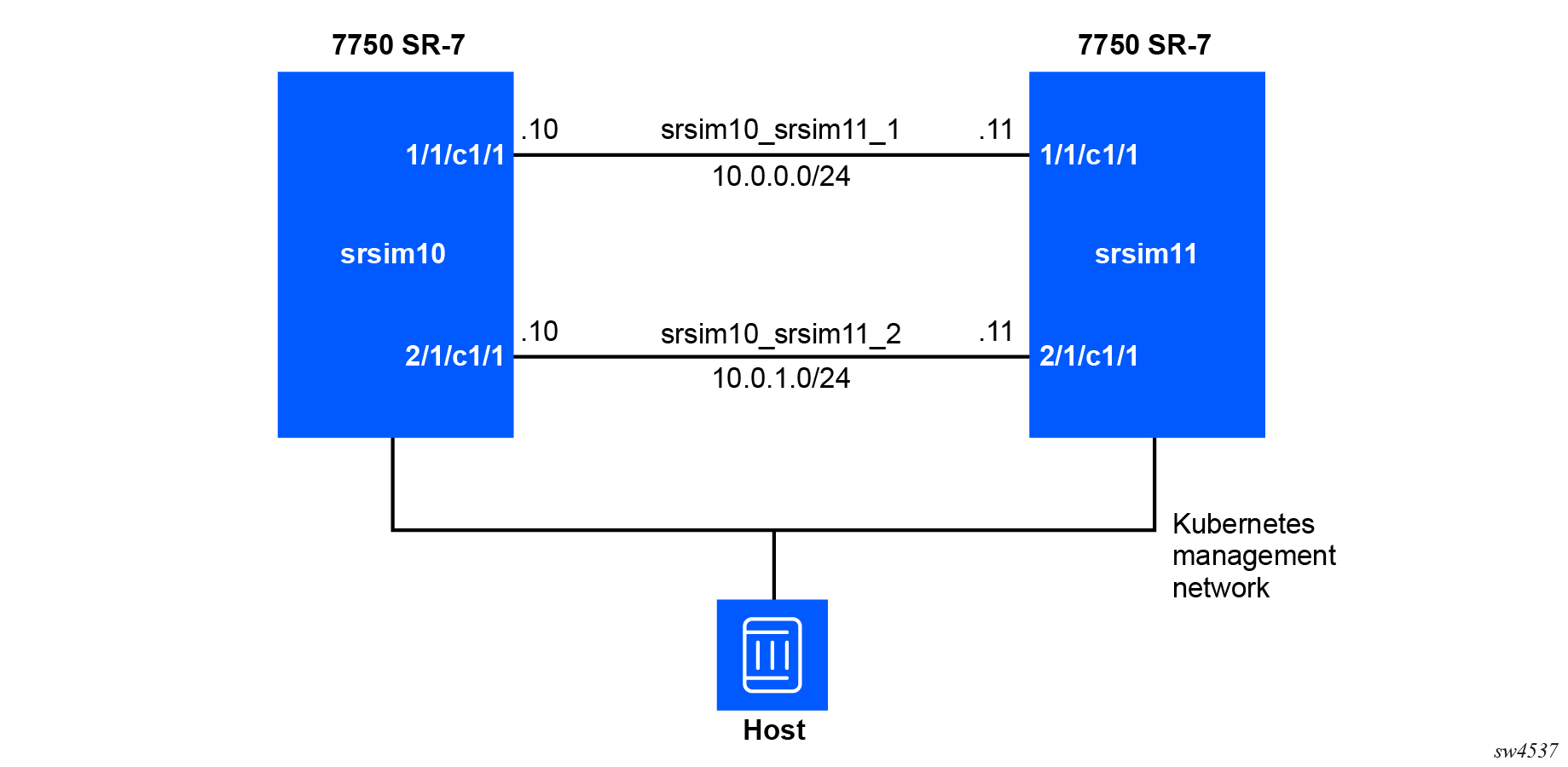
Each router consists of a number of containers. The following figure shows an example
srsim10 router container layout, where each box represents a separate
container.
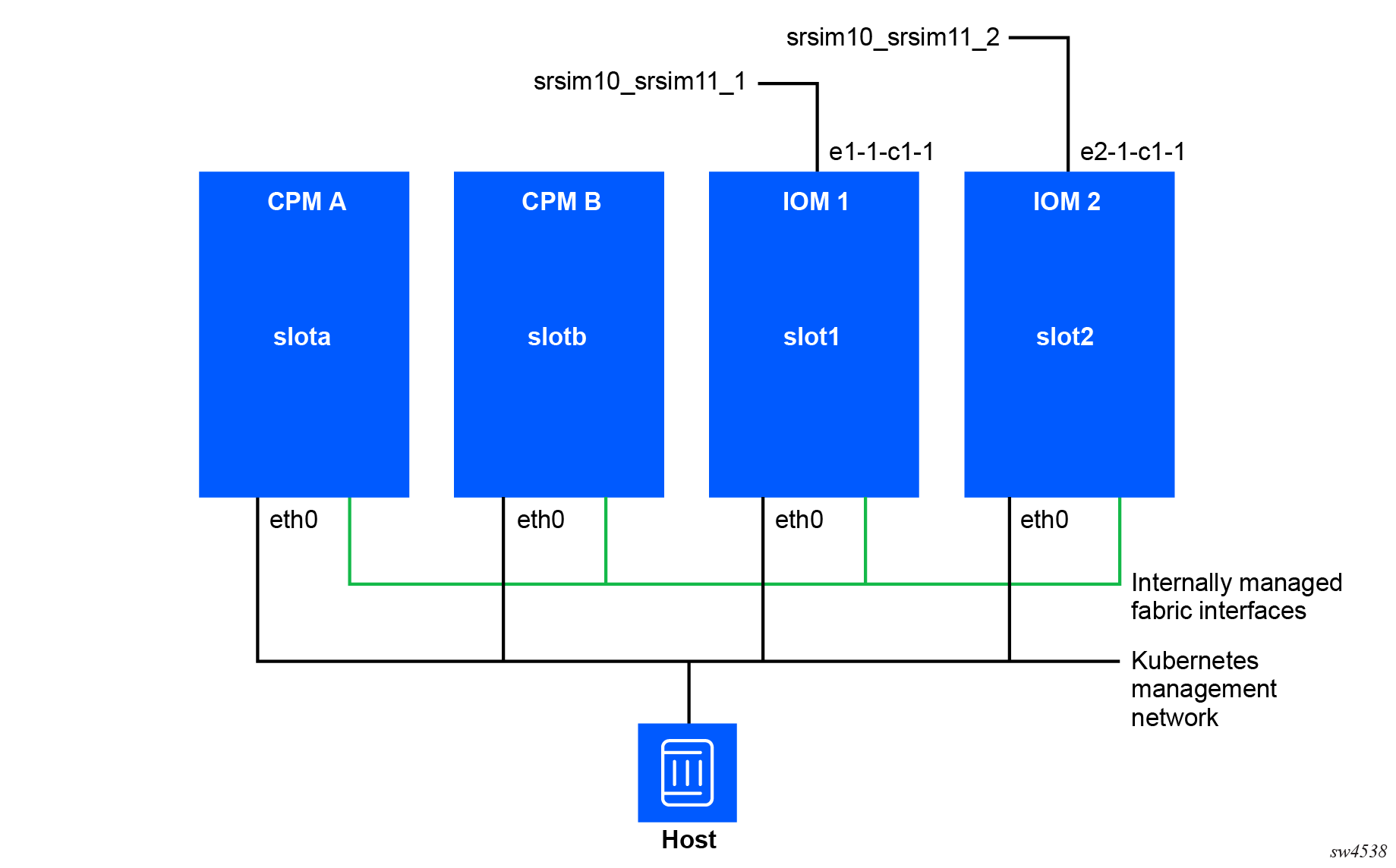
By using the Kustomize feature of Kubernetes this network can be deployed using a hierarchical template with minimal customization between routers.
The directory layout to create should look like this:
.
+-- kustomization.yml
+-- license.txt
+-- srsim10-srsim11-1-nad.yml
+-- srsim10-srsim11-2-nad.yml
+-- srsim-namespace.yml
+-- srsim
| +-- srsim-deployment.yml
| +-- srsim-service.yml
+-- srsim10
| +-- kustomization.yml
| +-- srsim10.cfg
+-- srsim11
+-- kustomization.yml
+-- srsim11.cfg Create each file in turn using the following information.
./kustomization.yml:
namespace: srsim
resources:
- srsim-namespace.yml
- srsim10-srsim11-1-nad.yml
- srsim10-srsim11-2-nad.yml
- srsim10/
- srsim11/
configMapGenerator:
- name: license
files:
- license.txtThis kustomization.yml file imports kustomization.yml files
from other directories (./srsim10/kustomization.yml and
./srsim11/kustomization.yml) by providing the directory name in the
resources section.
As explained in Integrated mode deployment, this
kustomization.yml file creates a ConfigMap named
license from the license.txt file. This
ConfigMap can then be used inside each Deployment
manifest.
./license.txt: This is the SR-SIM license file associated with your subscription.
./srsim10-srsim11-1-nad.yml:
apiVersion: 'k8s.cni.cncf.io/v1'
kind: NetworkAttachmentDefinition
metadata:
name: srsim10-srsim11-1
spec:
config: '{
"cniVersion": "0.3.1",
"name": "srsim10_srsim11_1",
"type": "macvlan",
"mode": "bridge",
"mtu": 9000
}'./srsim10-srsim11-2-nad.yml:
apiVersion: 'k8s.cni.cncf.io/v1'
kind: NetworkAttachmentDefinition
metadata:
name: srsim10-srsim11-2
spec:
config: '{
"cniVersion": "0.3.1",
"name": "srsim10_srsim11_2",
"type": "macvlan",
"mode": "bridge",
"mtu": 9000
}'srsim-namespace.yml:
kind: Namespace
apiVersion: v1
metadata:
name: srsim
labels:
name: srsim./srsim/kustomization.yml:
resources:
- srsim-deployment.yml
- srsim-service.yml./srsim/srsim-deployment.yml:
apiVersion: apps/v1
kind: Deployment
metadata:
name: srsim
spec:
selector:
matchLabels:
app: srsim
template:
metadata:
annotations:
k8s.v1.cni.cncf.io/networks: srsim10-srsim11-1@e1-1-c1-1, srsim10-srsim11-2@e1-1-c1-2
labels:
app: srsim
spec:
volumes:
- name: config-vol
configMap:
name: config
items:
- key: config
path: config
- name: license-vol
configMap:
name: license
items:
- key: license.txt
path: license.txt
containers:
- name: slota
image: localhost:32000/srsim:25.10.R1
volumeMounts:
- name: license-vol
mountPath: /nokia/license/license.txt
subPath: license.txt
- name: config-vol
mountPath: /nokia/config/config.cfg
subPath: config
securityContext:
privileged: true
envFrom:
- configMapRef:
name: router
env:
- name: NOKIA_SROS_SLOT
value: "a"
- name: slotb
image: localhost:32000/srsim:25.10.R1
volumeMounts:
- name: license-vol
mountPath: /nokia/license/license.txt
subPath: license.txt
- name: config-vol
mountPath: /nokia/config/config.cfg
subPath: config
securityContext:
privileged: true
envFrom:
- configMapRef:
name: router
env:
- name: NOKIA_SROS_SLOT
value: "b"
- name: slot1
image: localhost:32000/srsim:25.10.R1
volumeMounts:
- name: license-vol
mountPath: /nokia/license/license.txt
subPath: license.txt
securityContext:
privileged: true
envFrom:
- configMapRef:
name: router
env:
- name: NOKIA_SROS_SLOT
value: "1"
- name: slot2
image: localhost:32000/srsim:25.10.R1
volumeMounts:
- name: license-vol
mountPath: /nokia/license/license.txt
subPath: license.txt
securityContext:
privileged: true
envFrom:
- configMapRef:
name: router
env:
- name: NOKIA_SROS_SLOT
value: "2"The majority of the distributed deployment setup is achieved in this manifest resource file. It is similar to that used in the integrated SR-SIM deployment discussed in Integrated mode deployment; however, this resource manifest creates four containers per Pod.
The containers in this Deployment manifest are named slota,
slotb, slot1 and slot2 to align with the
SR OS numbering
for CPM A, CPM B, IOM 1 and IOM 2.
Each container requires a valid license file. The volumes section defines a
license-vol that is created using the license.txt key from
the license
ConfigMap.
Each container needs to have the chassis set to the correct type. In this the router is a
7750 SR-7 and therefore the router
configmap includes the environment variable
NOKIA_SROS_CHASSIS=SR-7.
The CPM containers must each have the chassis MAC address set. This must be set to the same
value in both CPM containers. The router
configmap includes the environment variable NOKIA_SROS_SYSTEM_BASE_MAC
to achieve this.
Each container must known which slot it is being deployed in. This is achieved on a
per-container basis by setting the environment variable NOKIA_SROS_SLOT. This
is set on each container rather than as part of a ConfigMap as it will not change
between deployments and is different on each container so cannot be reused.
./srsim/srsim-service.yml:
apiVersion: v1
kind: Service
metadata:
name: srsim
spec:
type: ClusterIP
selector:
app: srsim
ports:
- port: 22
targetPort: 22
protocol: TCP./srsim10/kustomization.yml:
resources:
- ../srsim
nameSuffix: "10"
labels:
- pairs:
app: srsim10
includeSelectors: true
configMapGenerator:
- name: config
files:
- config=srsim10.cfg
- name: router
literals:
- NOKIA_SROS_CHASSIS=SR-7
- NOKIA_SROS_SYSTEM_BASE_MAC=de:ff:ab:c9:bb:aaThis kustomization.yml file imports the kustomization.yml
file from the ../srsim directory, which in turn imports the deployment
manifest srsim-deployment.yml and the service manifest
srsim-service.yml.
The nameSuffix: "10" is important. This will suffix the Service,
Deployment and Pod resources with the number 10 which is used to differentiate
between the two routers. The labels section also updates the labels applied
to each deployment and pod in a similar way so that the service knows which element to link
to.
./srsim10/srsim10.cfg: A valid SR OS configuration
file for the srsim10 router.
./srsim11/kustomization.yml:
resources:
- ../srsim
nameSuffix: "11"
labels:
- pairs:
app: srsim11
includeSelectors: true
configMapGenerator:
- name: config
files:
- config=srsim11.cfg
- name: router
literals:
- NOKIA_SROS_CHASSIS=SR-7
- NOKIA_SROS_SYSTEM_BASE_MAC=de:ff:ab:c9:bb:bbThis kustomization.yml file imports the kustomization.yml
file from the ../srsim directory, which in turn imports the deployment
manifest srsim-deployment.yml and the service manifest
srsim-service.yml.
The nameSuffix: "11" is important. This will suffix the Service,
Deployment and Pod resources with the number 11 which is used to differentiate
between the two routers. The labels section also updates the labels applied
to each deployment and pod in a similar way so that the service knows which element to link
to.
./srsim11/srsim11.cfg: A valid SR OS configuration
file for the srsim11 router.
To deploy the network use the kubectl command:
kubectl apply -k .The output will look similar to this:
namespace/srsim created
configmap/config10-d52dfh957b created
configmap/config11-m8kb4kfh4c created
configmap/license-55hfghh822 created
configmap/router10-h5tchkdcb5 created
configmap/router11-bkg7tg27ft created
service/srsim10 created
service/srsim11 created
deployment.apps/srsim10 created
deployment.apps/srsim11 created
networkattachmentdefinition.k8s.cni.cncf.io/srsim10-srsim11-1 created
networkattachmentdefinition.k8s.cni.cncf.io/srsim10-srsim11-2 createdAlthough the Deployment, Service and
ConfigMap manifests are named srsim the created instances
include the nameSuffix from each devices kustomization.yml
file. The Kubernetes system knows how to link these dynamic names together so the operator
does not need to manage this.
The deployed items are created in the srsim namespace and can be viewed
using the kubectl command:
kubectl get -n srsim allThe output will look similar to this:
NAME READY STATUS RESTARTS AGE
pod/srsim10-75b96d94cd-qjmg8 4/4 Running 0 3m22s
pod/srsim11-75bdd76d8b-vrfz6 4/4 Running 0 3m22s
NAME TYPE CLUSTER-IP EXTERNAL-IP PORT(S) AGE
service/srsim10 ClusterIP 10.43.210.100 <none> 22/TCP 3m22s
service/srsim11 ClusterIP 10.43.121.107 <none> 22/TCP 3m22s
NAME READY UP-TO-DATE AVAILABLE AGE
deployment.apps/srsim10 1/1 1 1 3m22s
deployment.apps/srsim11 1/1 1 1 3m22s
NAME DESIRED CURRENT READY AGE
replicaset.apps/srsim10-75b96d94cd 1 1 1 3m22s
replicaset.apps/srsim11-75bdd76d8b 1 1 1 3m22sThe ConfigMaps created may be viewed with this command:
kubectl get -n srsim configmapThe output will look similar to this:
NAME DATA AGE
config10-d52dfh957b 1 4m27s
config11-m8kb4kfh4c 1 4m27s
kube-root-ca.crt 1 4m27s
license-55hfghh822 1 4m27s
router10-h5tchkdcb5 2 4m27s
router11-bkg7tg27ft 2 4m27sTo identify the IP address of the deployed routers use the kubectl command
to query to deployed Services:
kubectl get -n srsim serviceThe output will show the IP addresses that can be used to SSH to the devices. The output will be similar to this:
NAME TYPE CLUSTER-IP EXTERNAL-IP PORT(S) AGE
srsim10 ClusterIP 10.43.210.100 <none> 22/TCP 6m59s
srsim11 ClusterIP 10.43.121.107 <none> 22/TCP 6m59s